Rickubis Bird
Page #3a:
Cormorants
This page was
born (split off from 11/11/2008) page 6/24/2020. Rickubis
designed it. (such as it is.) Last update: 12/04/2024
Images and contents on this page
copyright ©2002-2024 Richard M. Dashnau
Go
back to my home page, Welcome to rickubis.com
Go back to the RICKUBISCAM
page.
----------------------------------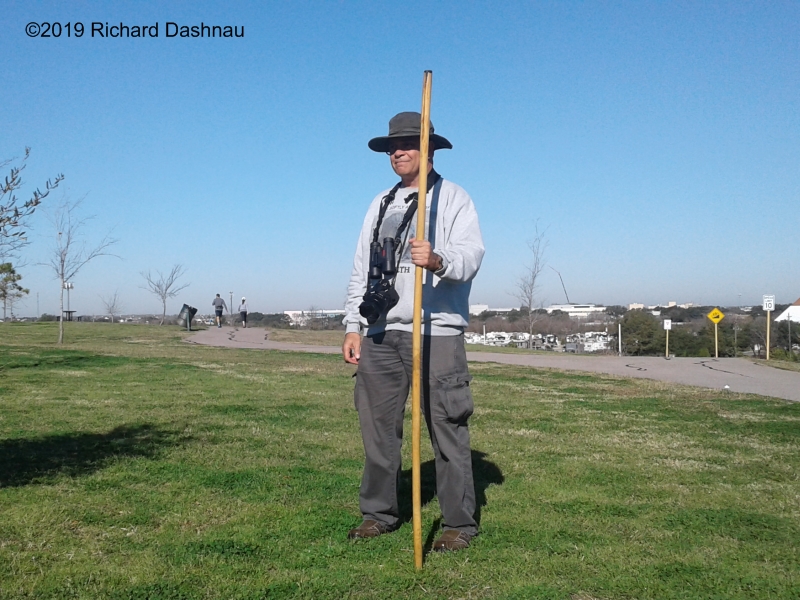
That's me on a trail at Archbishop Fiorenza Park,
sometime in 2019. This
page talks about Cormorants. Although I've seen them at BBSP,
I've had more luck watching
them at other places, such as Archbishop Fiorenza Park. As time
has gone by, I've learned a bit more about them. My earlier
writings are therefore a bit different than the
more recent ones. But, that's what happens as we learn.
11/09/2024
Fiorenza
Park while on
the low
bridge, I
noticed a
turtle sharing
a branch with
some
Cormorants. It
was at least
50 yards away
(the arrow in
the first
image below
shows where
they
were.
When I started
taking
pictures of
the
interesting
sharing
situation, one
of the
Cormorants (I
believe these
are Neotropic
Cormorants
(Nannopterum
brasilianum))
decided to act
like a brat. I
captured some
of that in a
short video
clip,and some
of these
images are
frames from
the video,
while some are
from photos.
In the 4th
picture below,
the turtle has
its mouth
open. Reptiles
"yawn" for may
reasons. In
the photo, the
turtle seems
to be talking
to the birds.
That seems
unlikely, but
after many
years of
watching and
reading about
Nature; I've
learned that
almost
anything is
possible.
Gaping jaws to
not have to
produce sound
to communicate
a message.
Sometimes a
yawn
is just a
yawn, and at
other times it
could be a
threat
display.
Context is
important. You
can see older
pictures of
Cormorants at
Fiorenza Park
on my
Cormorants
page.
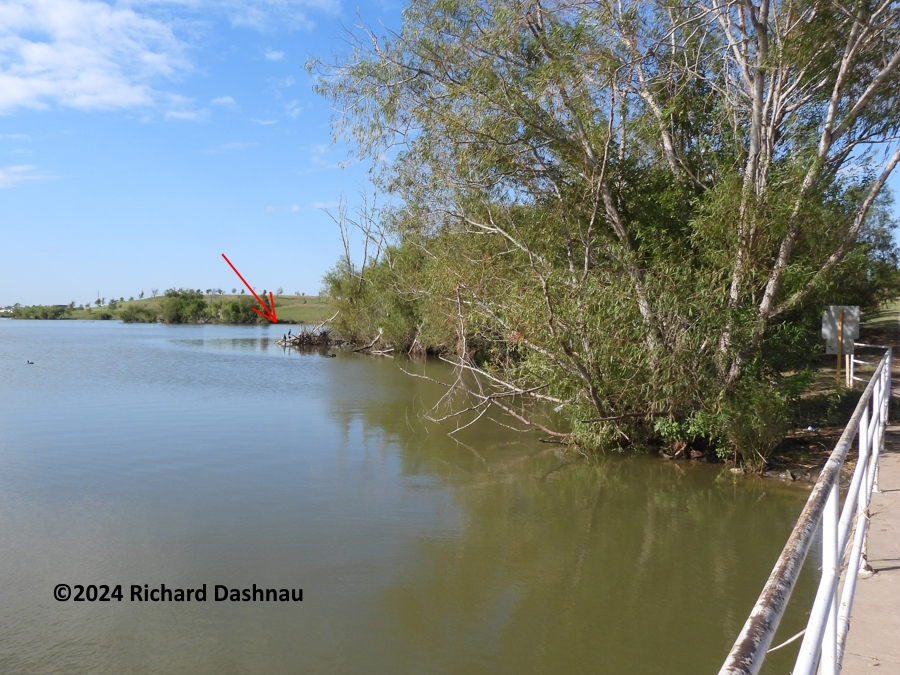
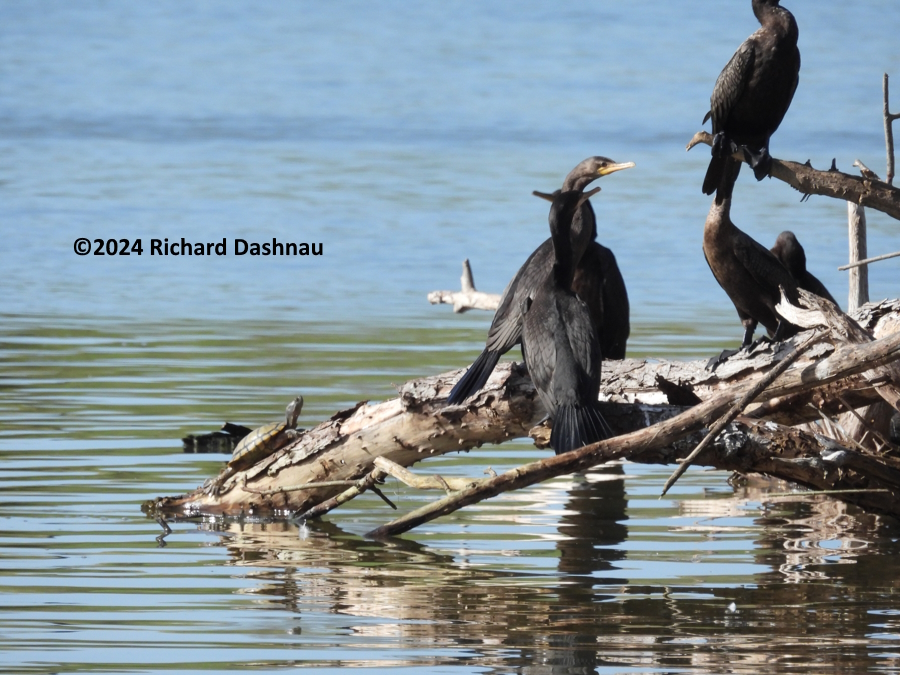

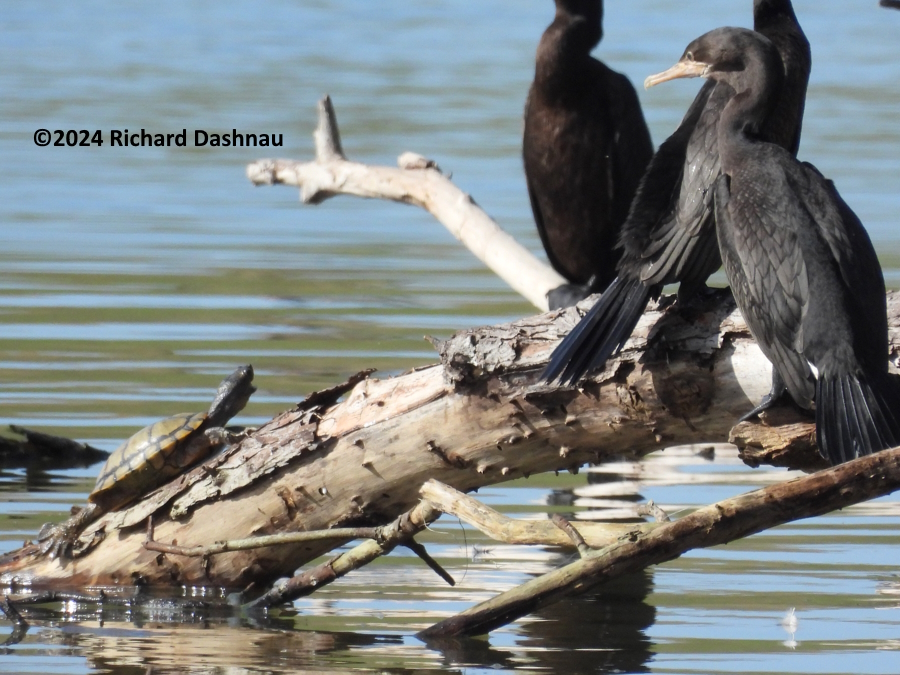
The
turtle is
probably a
Pond Slider (Trachemys
scripta),
possibly a
"melanistic"
Red Eared
Slider.
The last
Cormorant to land apparently didn't
want to share. It gently tweaked the
turtle's head...
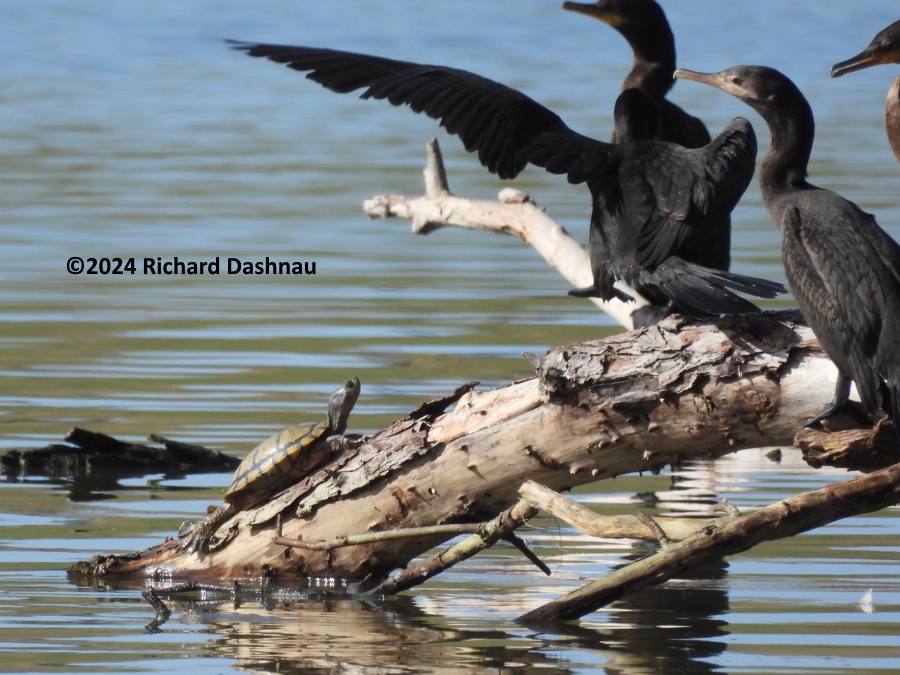
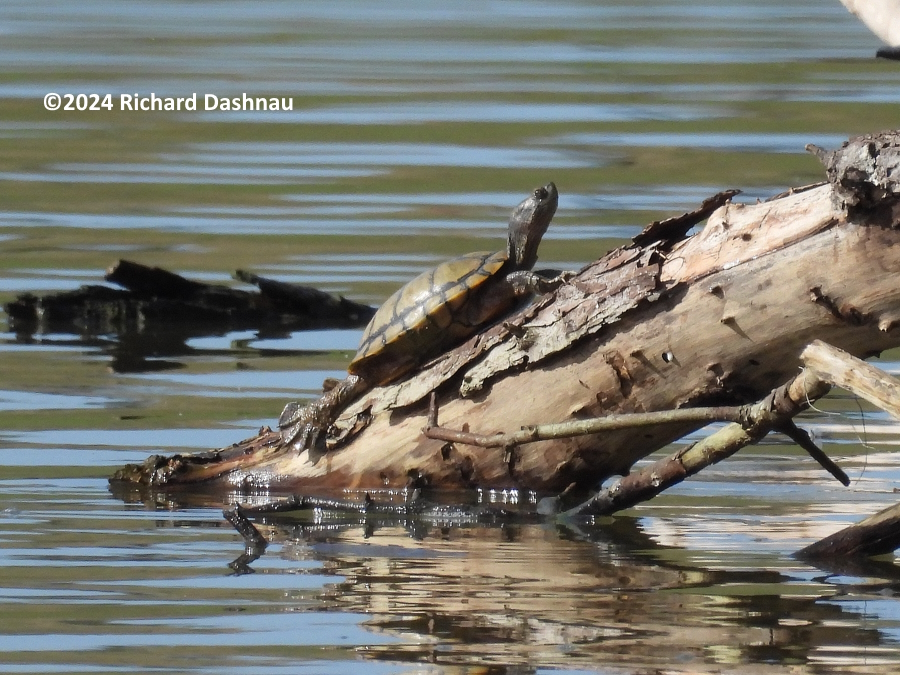
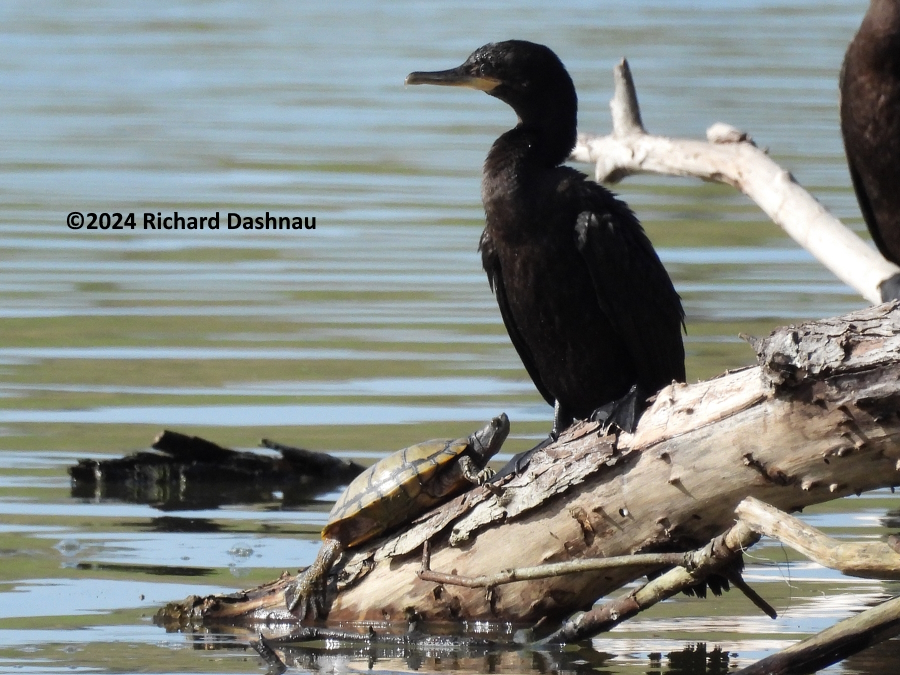
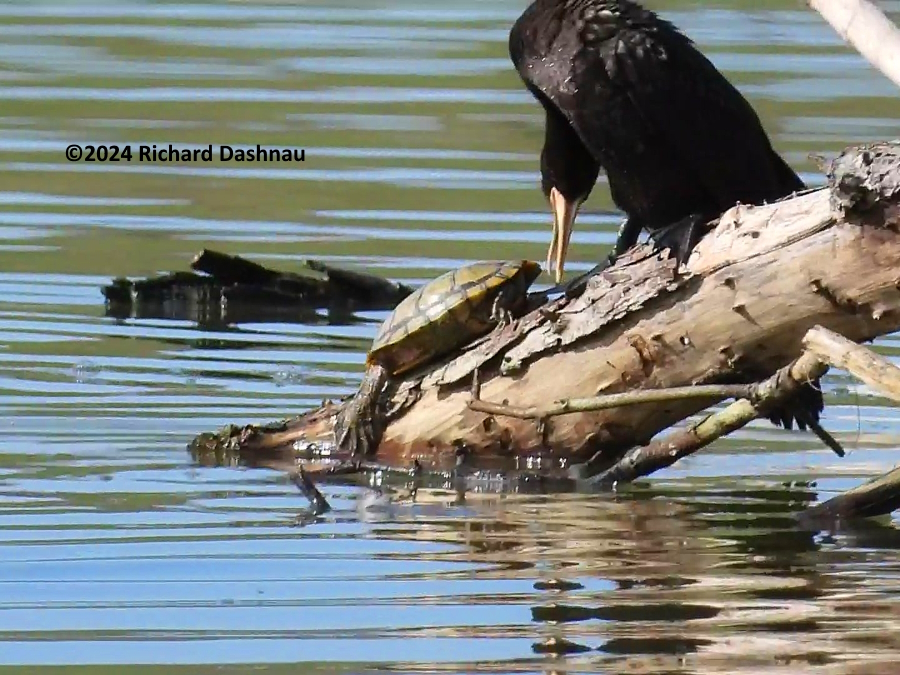
...and
gently probed
the turtle's
carapace with
its beak.
The turtle
retreated a
little. When
the Cormorant
looked away,
the turtle
tried to move
a little
higher. The
Cormorant
turned back.
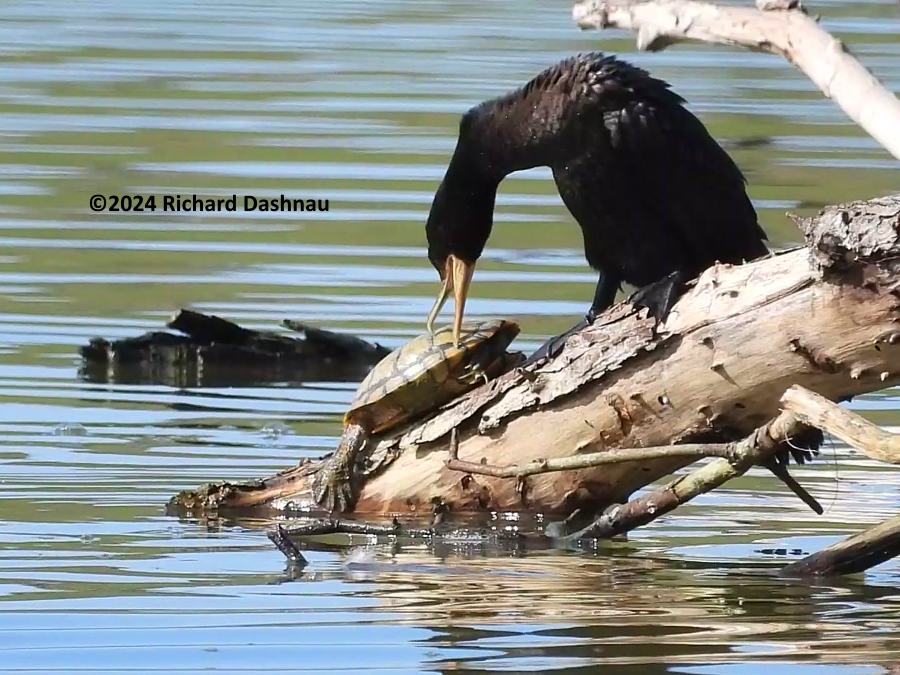
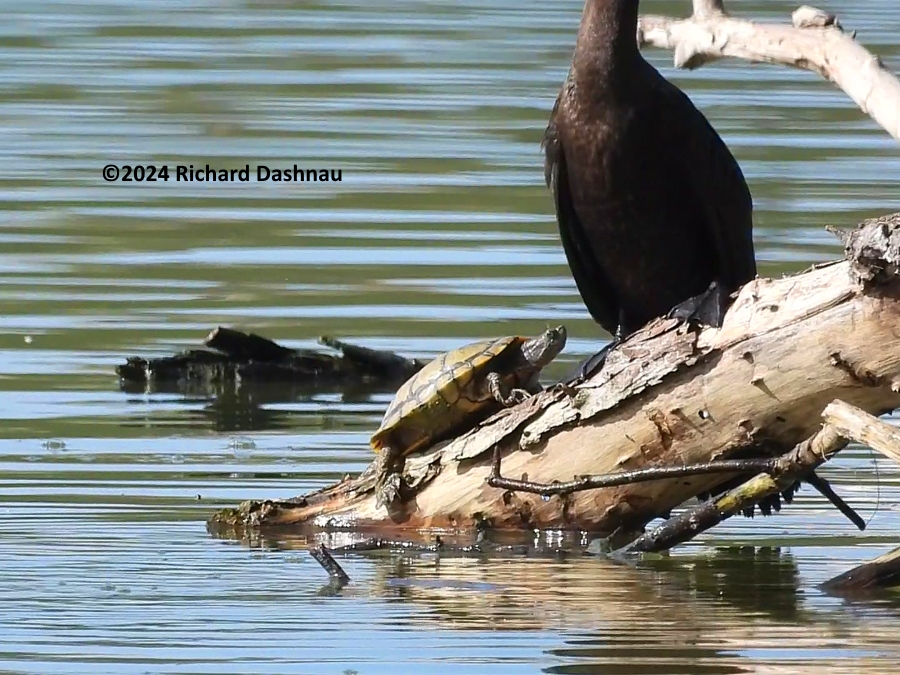
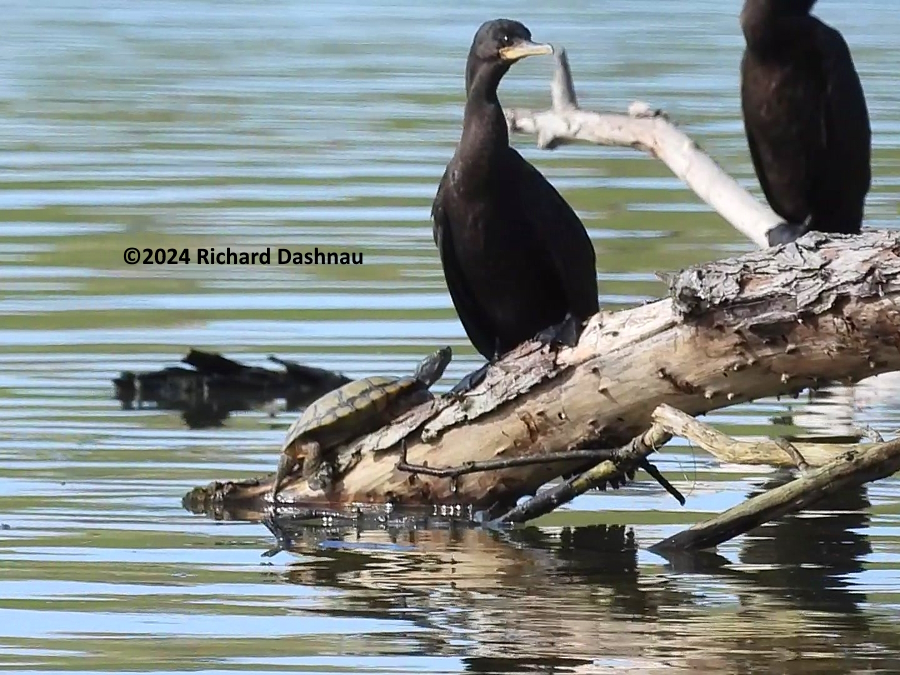
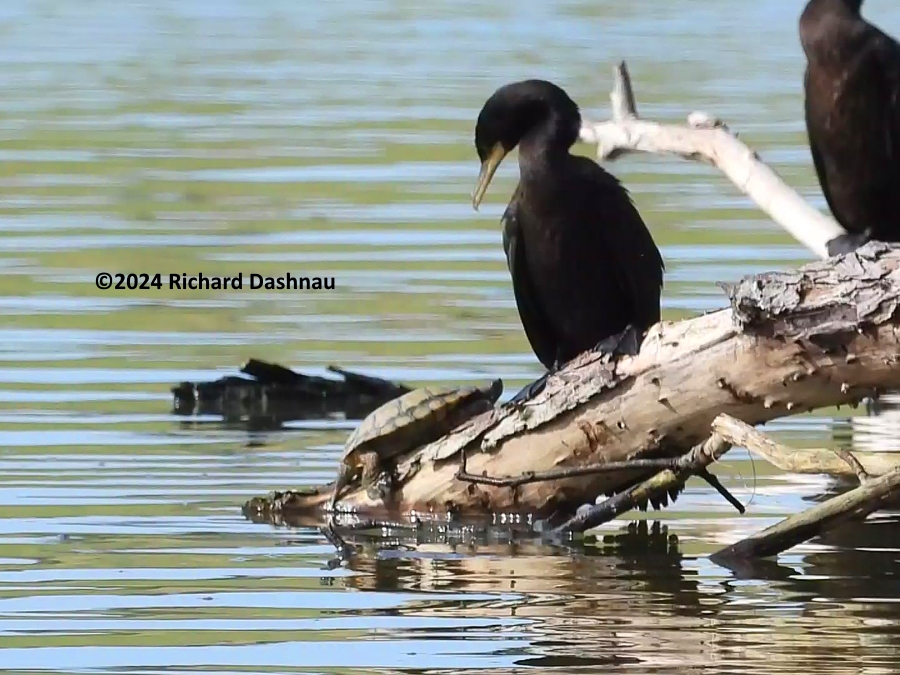
This
time, it
"nipped" the
turtle's head
(still gently,
it
seemed).
But it poked a
bit more and
caused the
turtle to back
away and slide
off the
branch. None
of this
movement
seemed
especially
aggressive.
Activity was
at a leisurely
pace. Even the
turtle's slide
off the
log-backwards-wasn't
rushed.
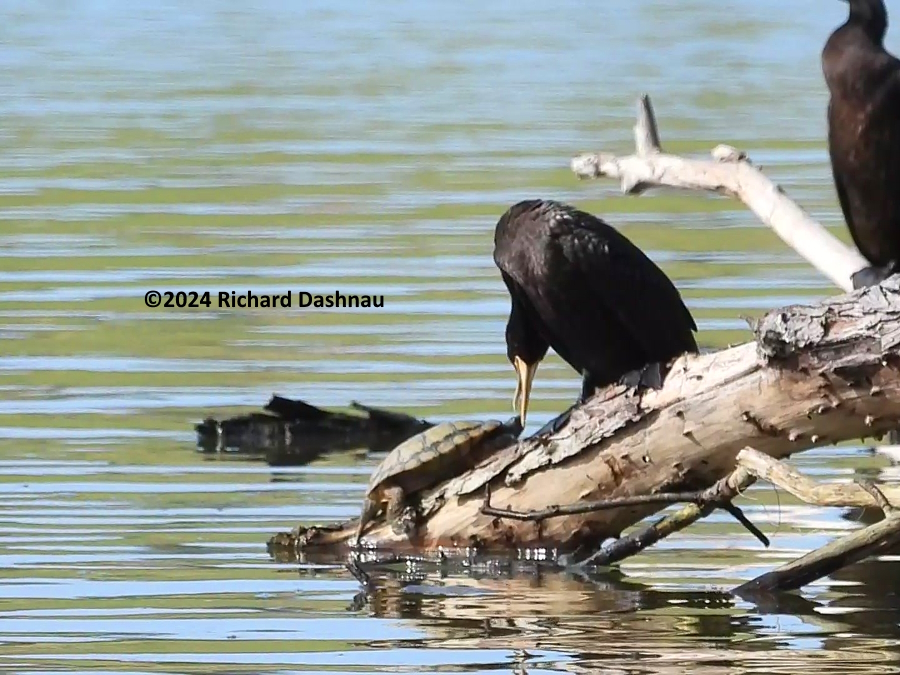
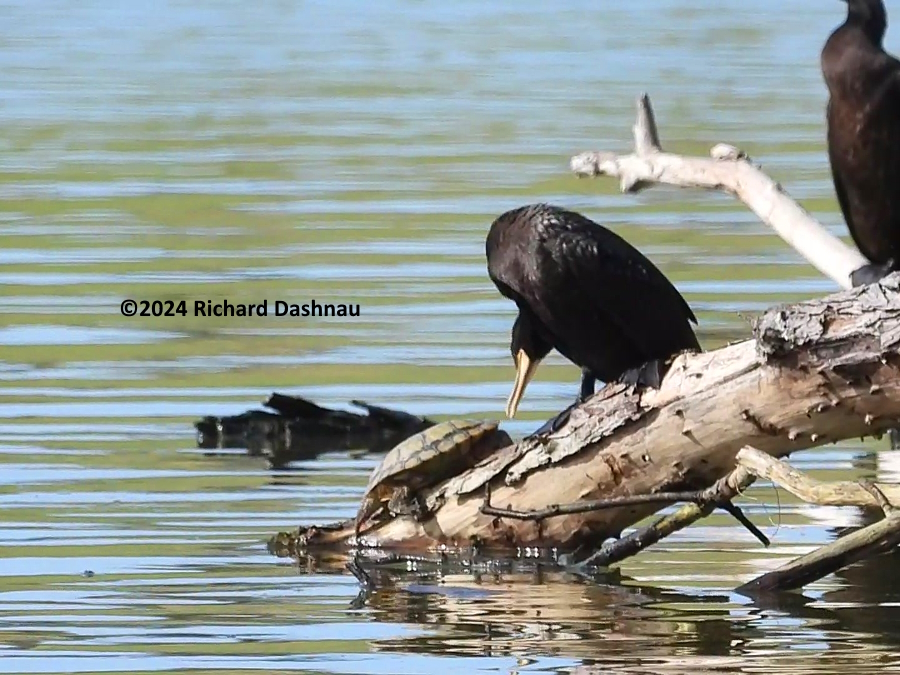
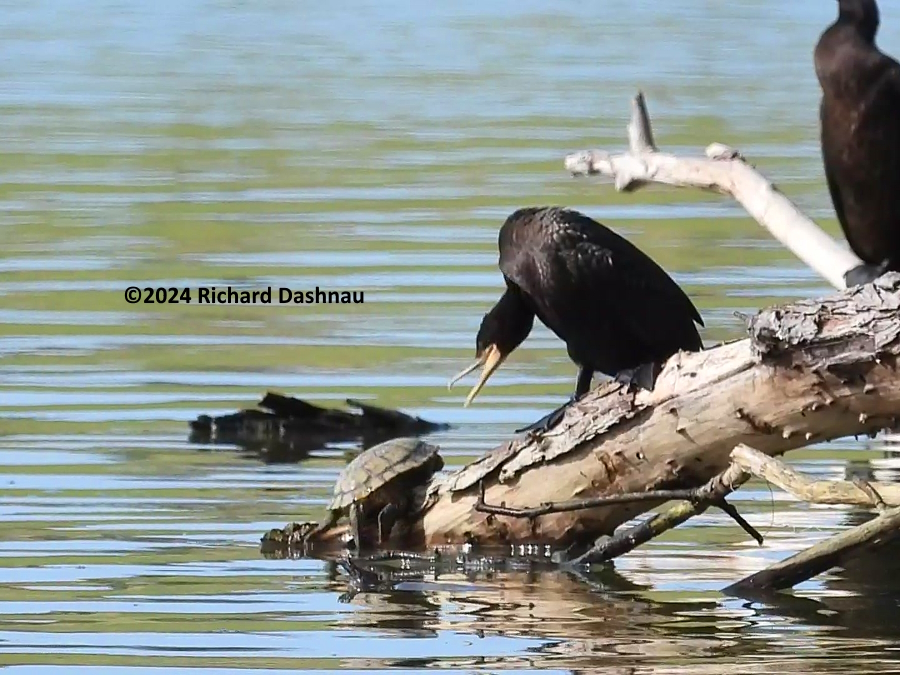
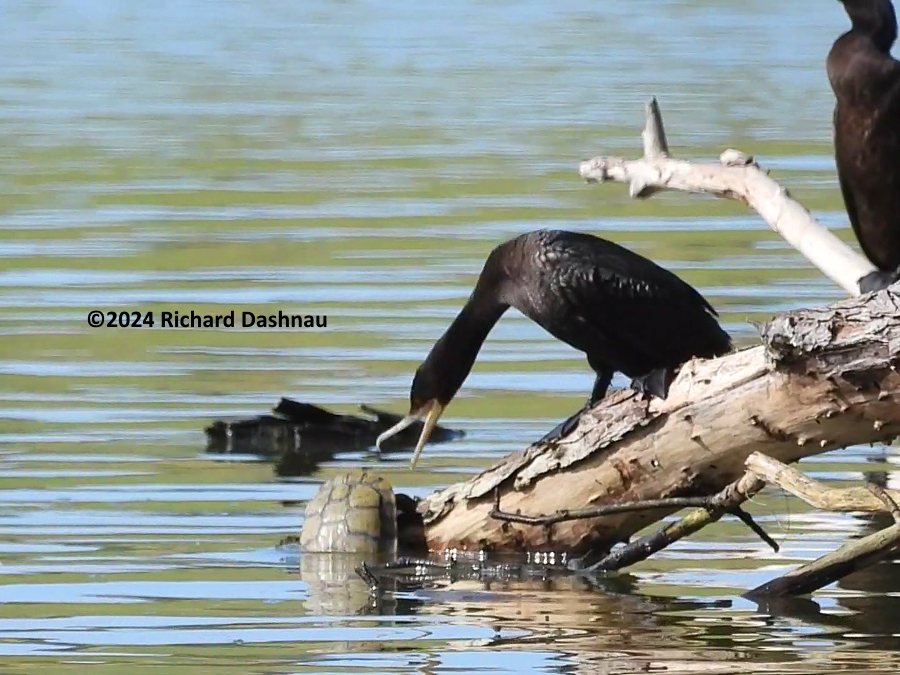
Even
after the
turtle
submerged, the
Cormorant
poked around a
bit under the
water. I've
put some of
the pictures
and the
captured video
together into
this
edited video.

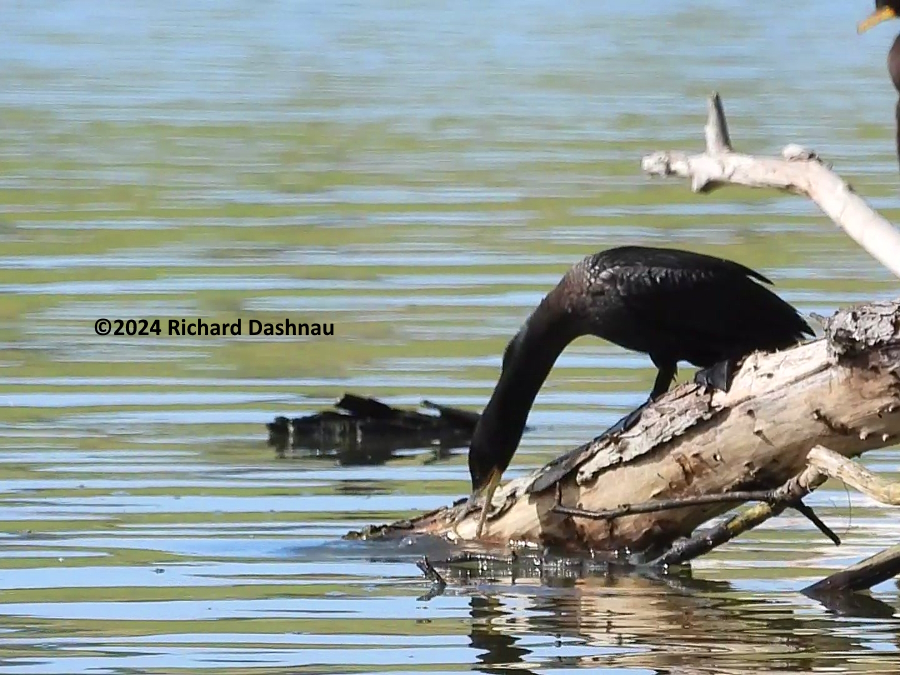
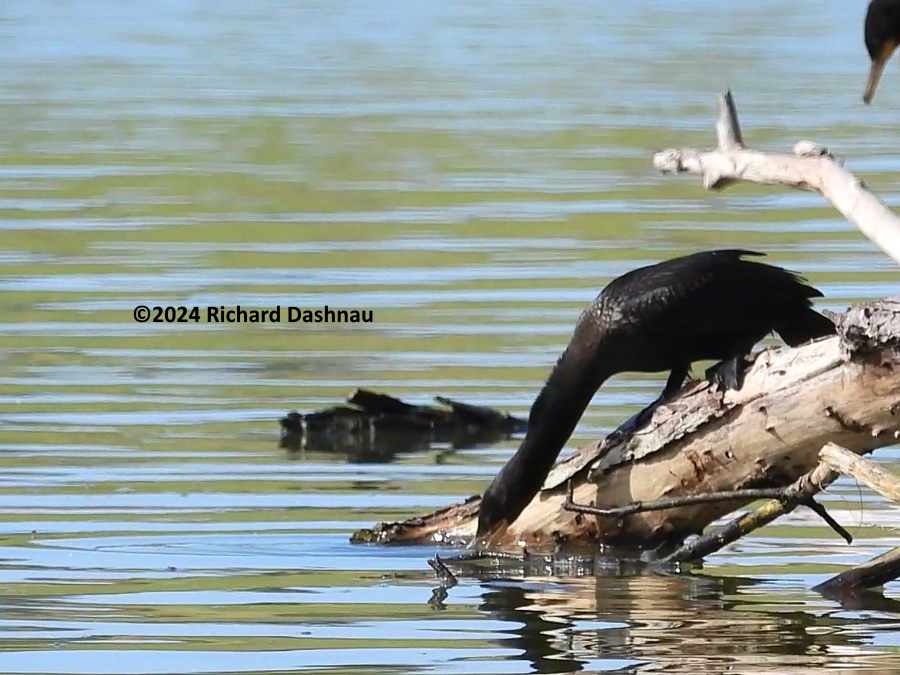
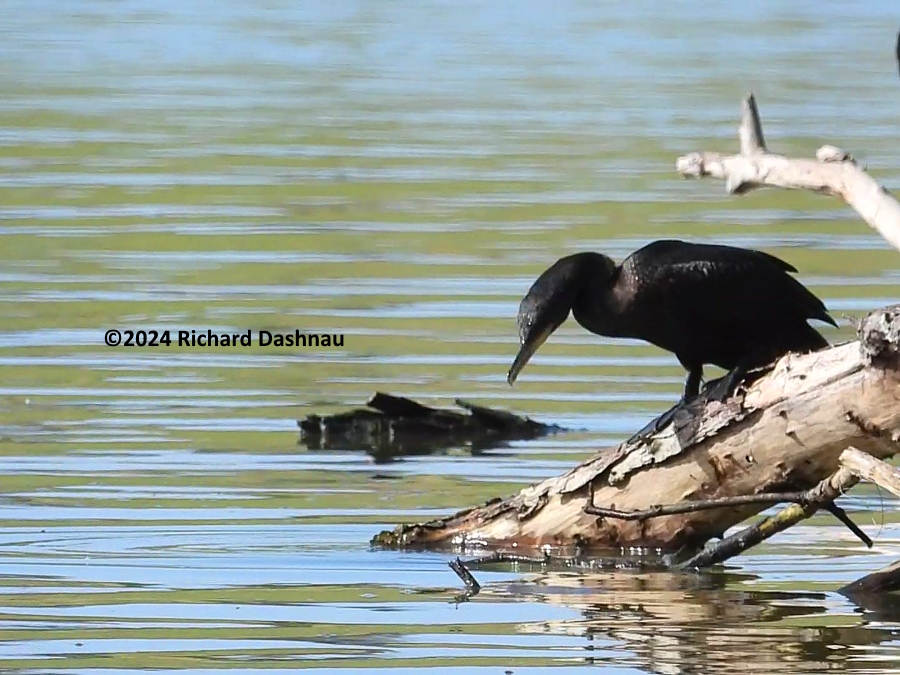
On 11/28/2021 I
noticed a cormorant struggling with a large bowfin--at least
large for the cormorant. After about 5 minutes, the cormorant
was successful. It was a
bit of a struggle, and you can see that in
this video clip.

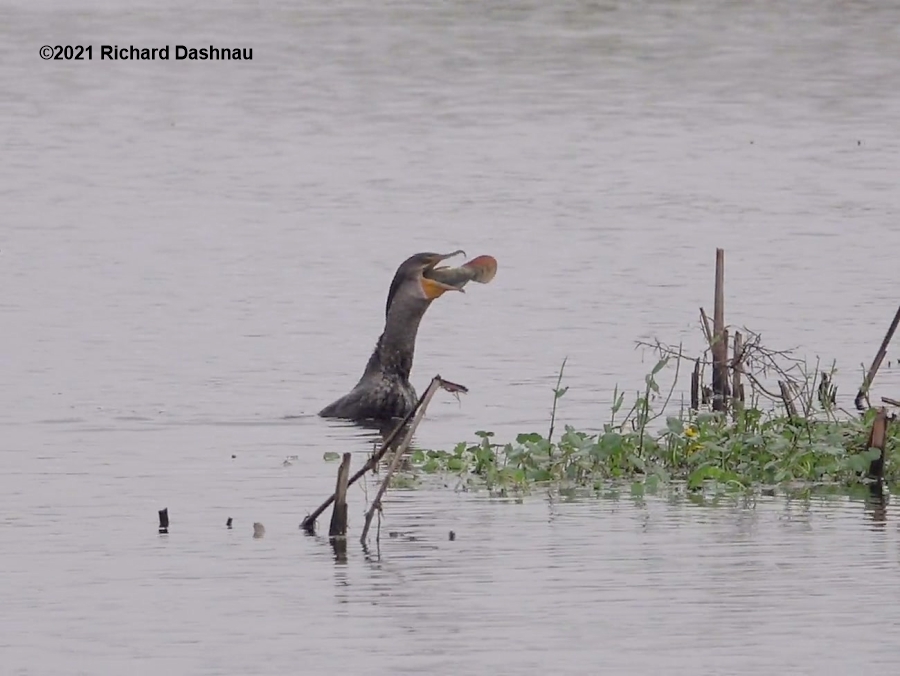
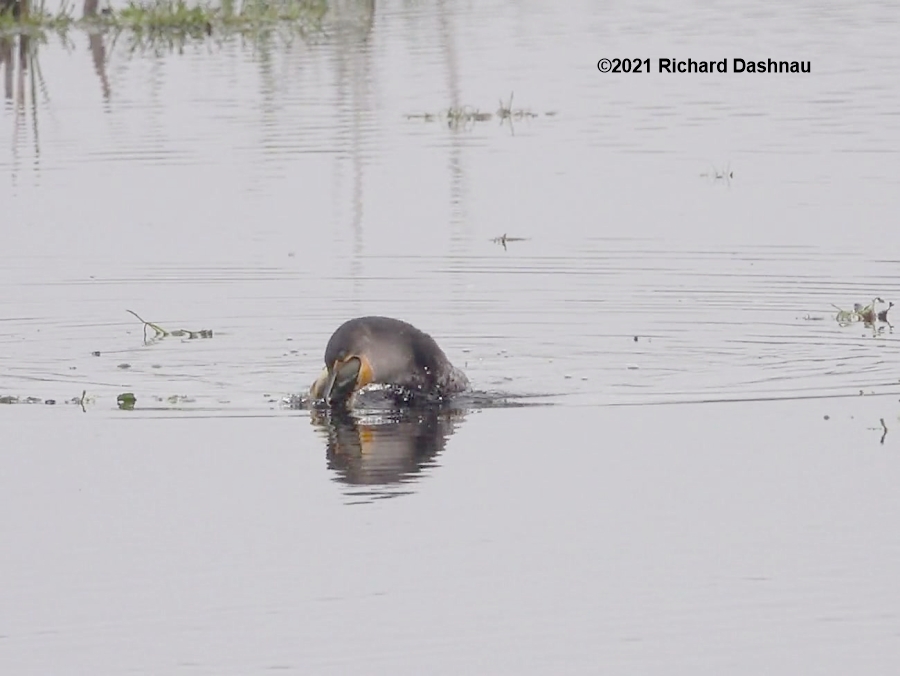
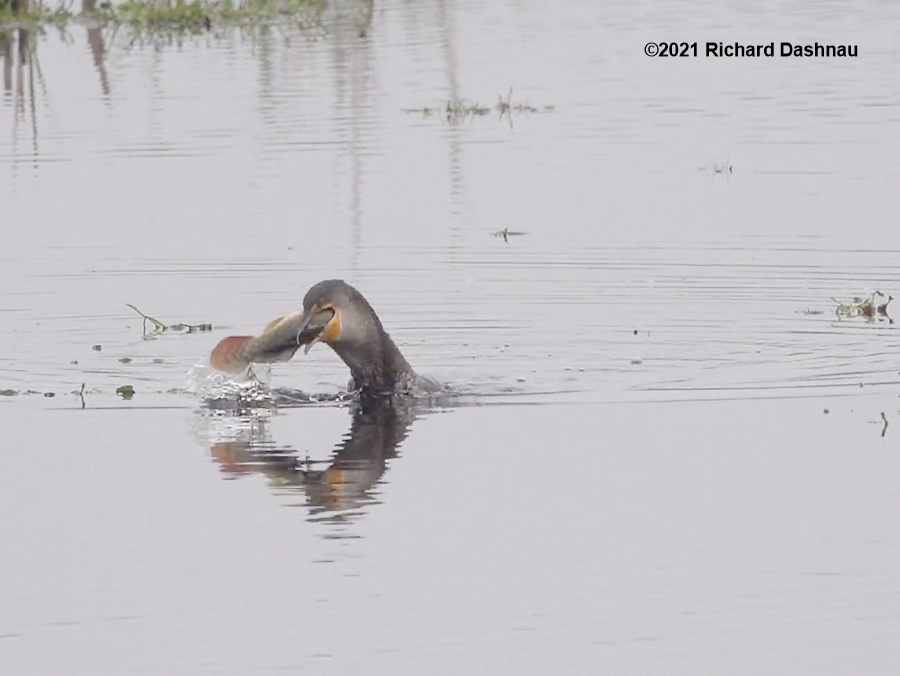
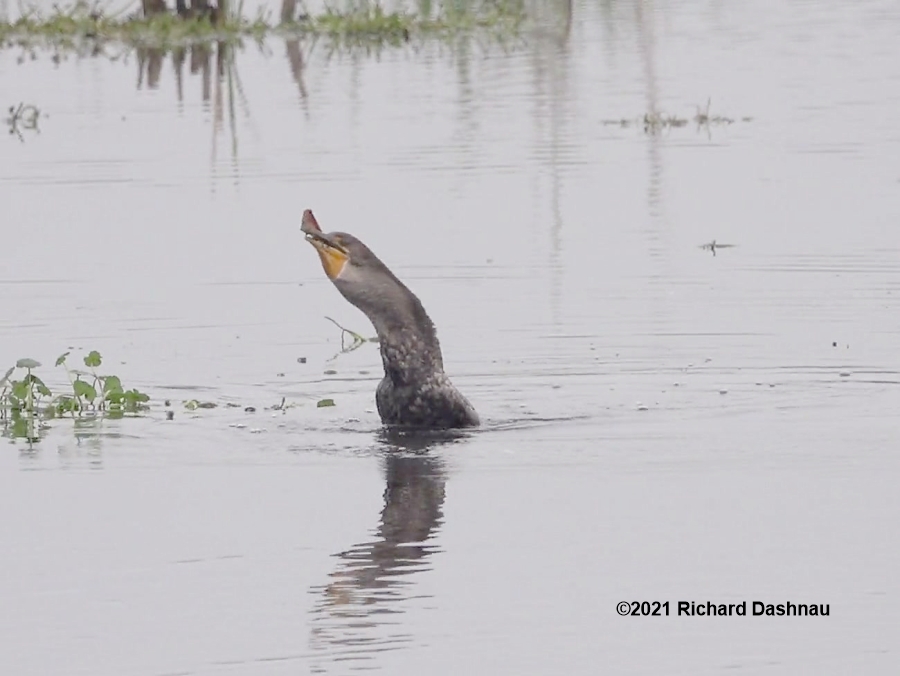
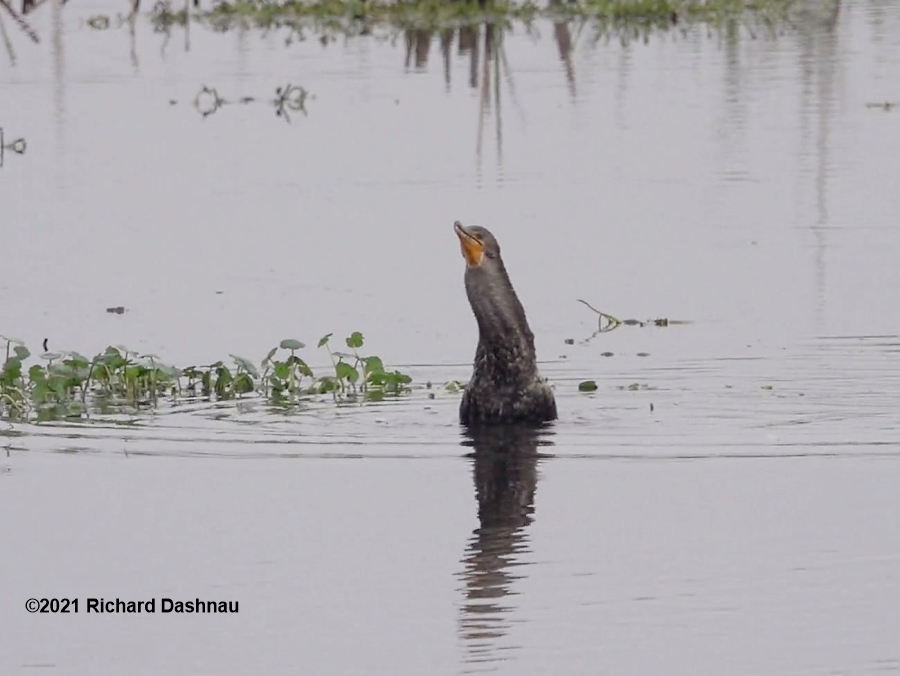
01/09/2021 I've
been going to Fiorenza park more often lately. It's not too far from my
home (about 20 minutes' drive) and very few people are there when I am.
As usual for the winter
months, many White Pelicans and Cormorants appear there. I really
enjoy seeing them forage together in large rafts, and have taken a
number of photos and video clips over the last few weeks.
I've chosen to post what I saw
today (January 9th) because I captured some unusual footage.
The
morning
started out a bit chilly. As the sun got higher, things started
to warm a bit, so prey started moving in the water. The
Pelican/Cormorant flotilla started around (usually
there seems to be just one flotilla, but it's REALLY BIG.)
Single birds started to forage, especially near the
narrows at the low sidewalk bridge. This is where I've gotten
the footage of
cormorants and grebes at work before, and I was trying for more.
I had just focused on a foraging Neotropic cormorant in
HFR (High Frame Rate) mode (480fps) when it decided to
take off. It flew directly to my right, and therefore
remained in focus most of the time. I'd zoomed in closer than I
normally would because I'd expected to film prey capture, but
was
able to keep the Cormorant in frame as it flew. In High
Framerate Mode, focus is set once I start, so it's easy for a
subject to move out of focus. This time I got lucky, and the
video is
pretty cool. The image below is a frame from the video. Take a
look at the
video
here(mp4).

Neotropic
Cormorant
Takeoff! (It's got white
"cheeks")
Aug
13 2020 Like
almost
everyone these days, I've been staying inside. I have
stopped driving too far...
for
purely
recreational purposes.
I've also
been avoiding parks that take much time drive to; since we are
generally asked to limit travel.
Today
I went out to Archbiship Fiorenza Park phase
2(second time this week!) and I was happy to see it wasn't
crowded. I walked, but not far, since I wanted to keep an eye
on my car.
I saw
quite a few things. Cormorants often dive for fish near the
bridge (I have posted other pictures taken there), Here are
two pictures of
a
Neotropic Cormorant (Phalacrocorax brasilianus) that was
hunting that day. The striking white border around the back
edge of its beak is a good identification mark.
The third
image is a frame grab from a video clip of one of the
cormorants (I can't tell if it's the same one in the photos)
that had surfaced with a fish. I've tried to
capture
video of that act many times. I have to focus on a
section of the surface of the lake, and hope to catch the
subject surfacing in frame and in focus. The video,
shown at this link (mp4),
turned out nice, for once.

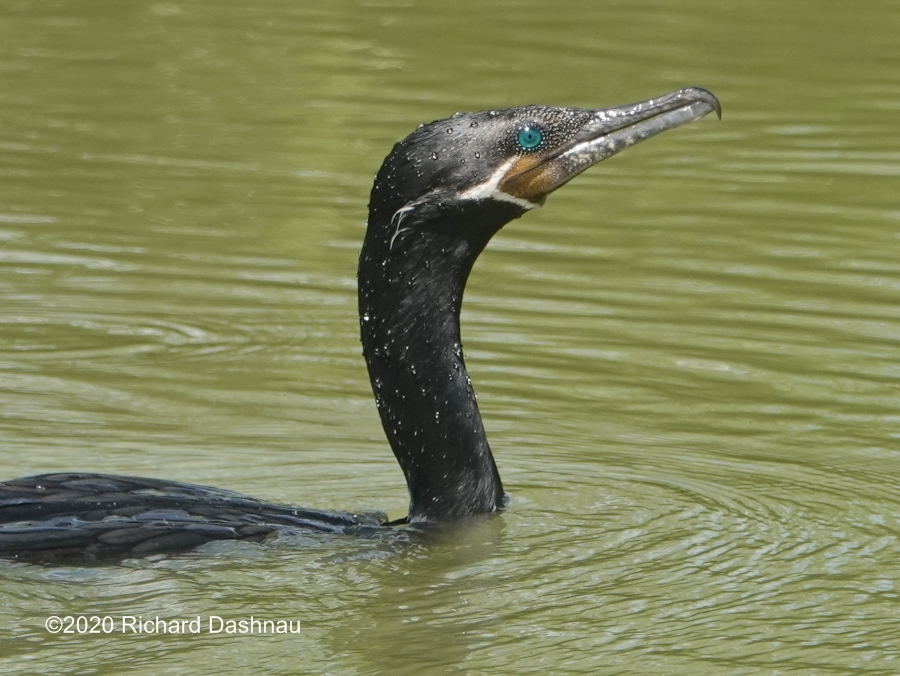

12/07/2019-12/14/2019
I
was at Fiorenza Park last weeked. I noticed some Pied-Billed
Grebes hunting, along with the usual Cormorants. After a while, I
noticed that the grebes started catching fish.
One of them caught and swallowed a nice-sized fish (some kind of
crappie, or maybe a tilapia, I think). Then, I was surprised
to see them catching and eating armored catfish! I caught some of
this on video. Some of the attached images are frame grabs from
the video, and some are just photos. While shaking and
"juggling" their armored catfish, it seemed that the grebes
were handling them by the fins, and violently shaking them by
twisting their heads. I've seen Yellow-crowned Night Herons use
this shame technique while breaking off the claws and
legs of crawfish. Perhaps the grebes were trying to break
off the sharp "barbs" on the fins of the fish before they ate
them. It appeared that the grebe would lift the fish by one of the
barbs,
then violently shake it. I couldn't see for sure if the barbs were
breaking off, though. Then, I returned to the park on 12/14.
This time I caught some video that shows that the
grebes are
breaking
the sharp spines off of
the catfish! I've added that clip to the edited
video. The 4 images on the bottom row below are frame-grabs that
show when the spike has been broken off. The arrow in
the last image is pointing to the spike in the grebe's beak.
I've
edited
the clips together into this
video showing the differing techniques.
The
cormorants used a different technique to subdue their fish.
Their method employed the sharp hook at the tip of their
top beak (upper mandible). The Cormorants tossed their armored
fish
until it
was upside-down. This exposed the fish's softer underside to
that hook. Then the cormorants forced the hook into the fish
(by violent shaking)--most likely doing major damage and
causing
the
fish to weaken and relax its spines. This is all
guesswork driven by what I can see in the video clips.
I've edited them together into this video showing the
differing techniques.
About the
armored catfish....
I've been
calling these fish plecostomus for a long time. I was aware
that there were a few different species of these in local
bodies of water--but I had read somewhere that
calling
them all "plecostomus" was acceptable. Just recently, I've
finally found some information that may help tell these
species apart. From the sources I can find, it
seem that
the most common armored catfish are one of two genus:
The Hypostomus genus and Pterygoplichthys genus.; with the two
most likely species as Hypostomus plecostomus
and
Pterygoplichthys anisitsi. (that's pronounced
ter-go-plik-thees according to this source listed ). The
clearest descriptions I've found online were in this document
on the Edwards Aquifer website:
https://www.edwardsaquifer.org/wp-content/uploads/2019/02/2005_Howells_SuckermouthCatfishes.pdf or, if
that document gets moved, here is the page with the link:
https://www.edwardsaquifer.org/doc_publications/exotic-suckermouth-catfishes-family-loricariidae-in-texas-waters/
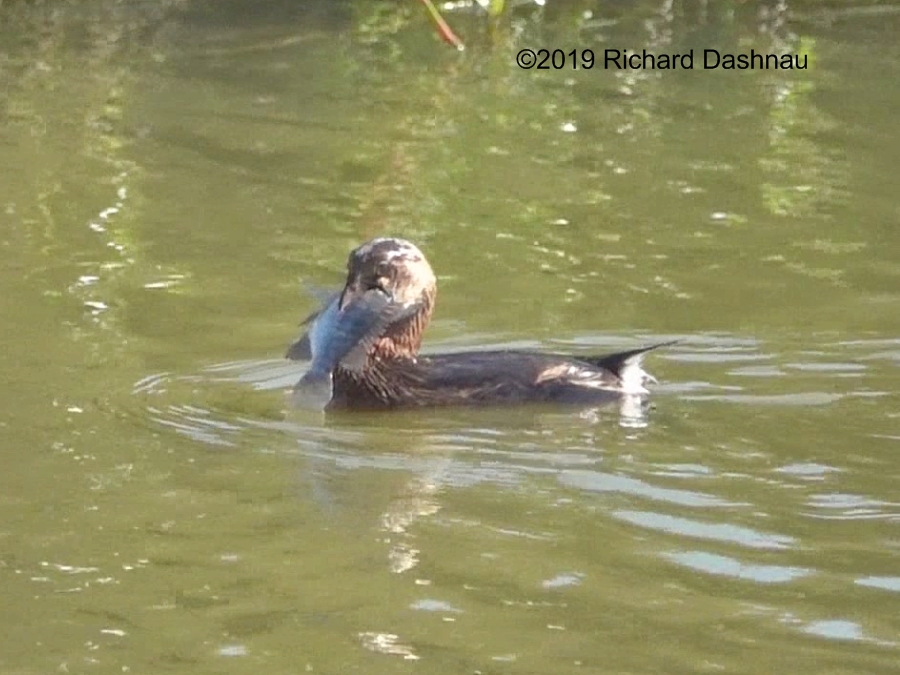
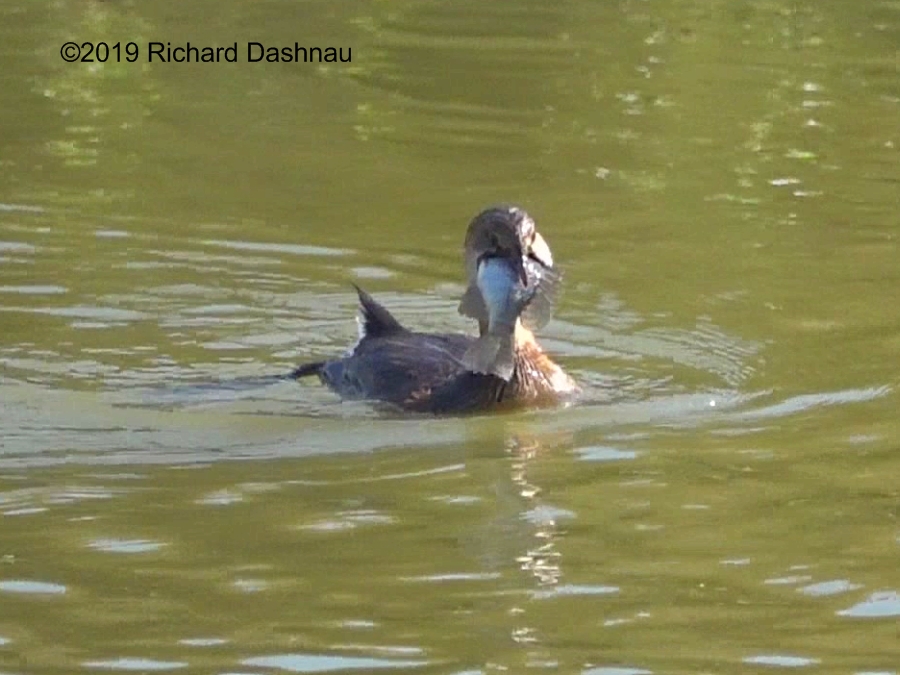
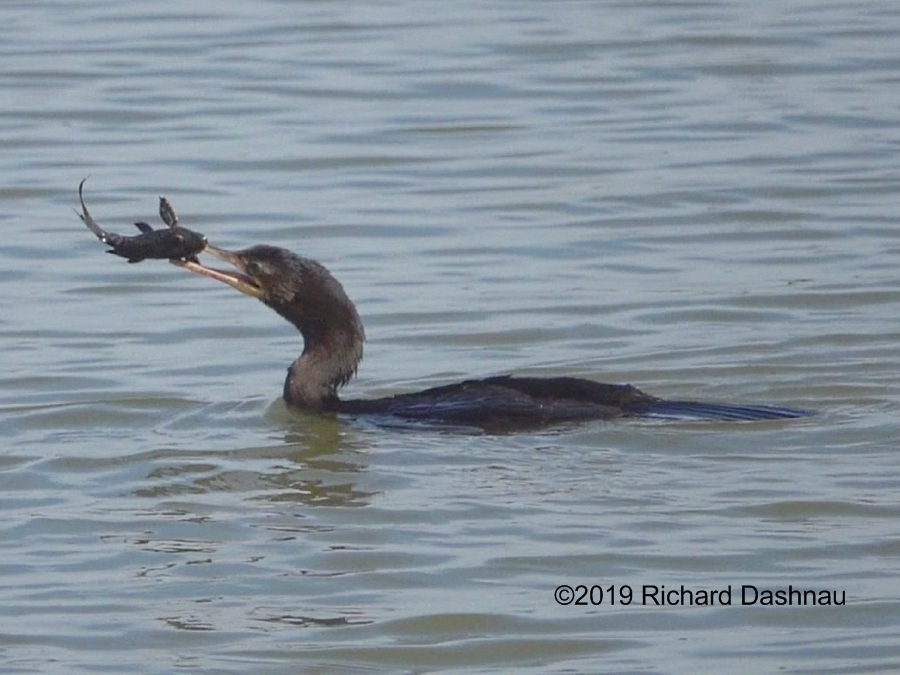
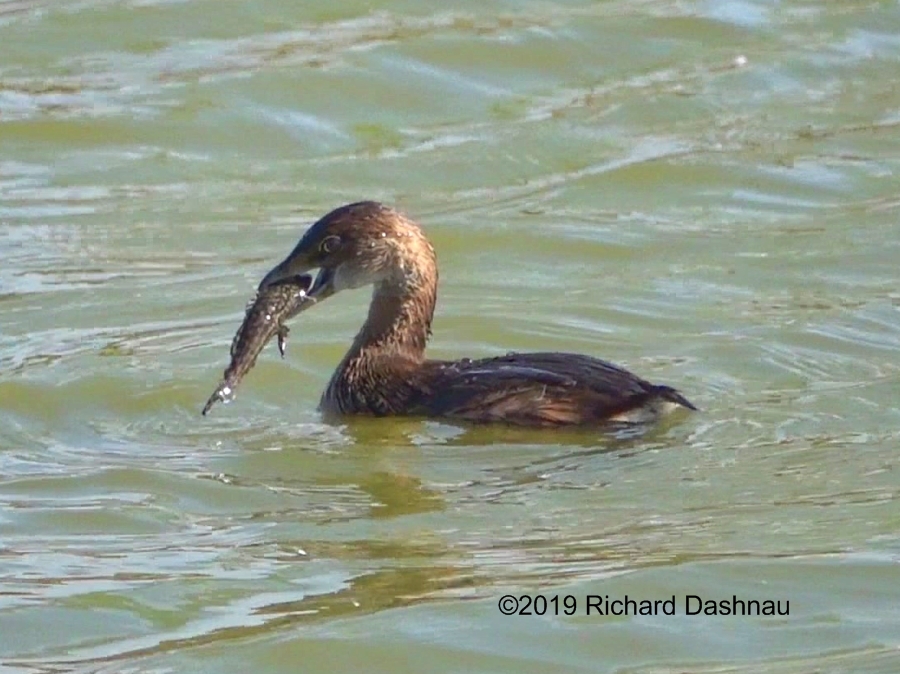
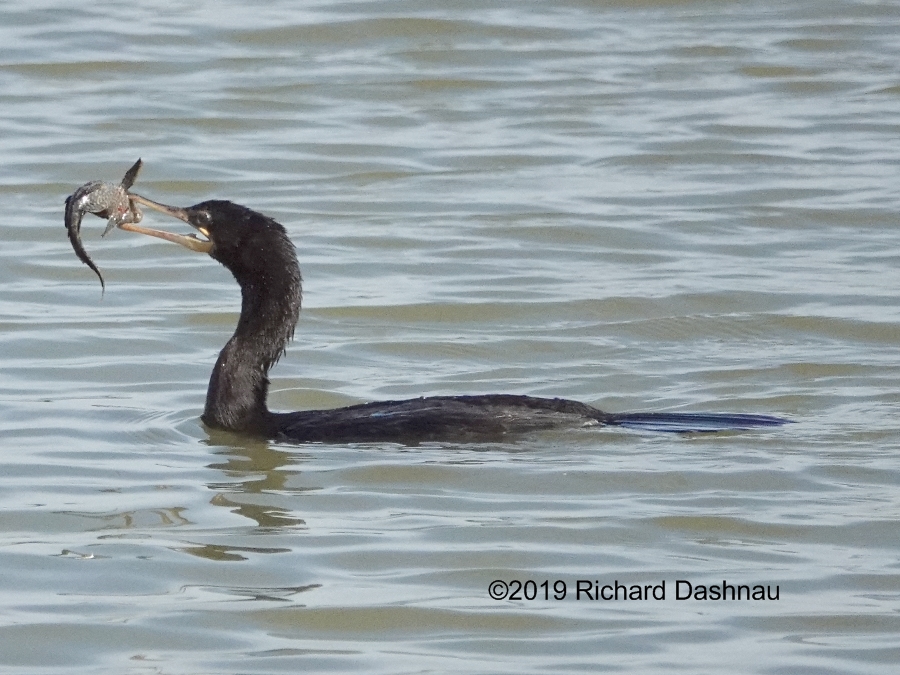
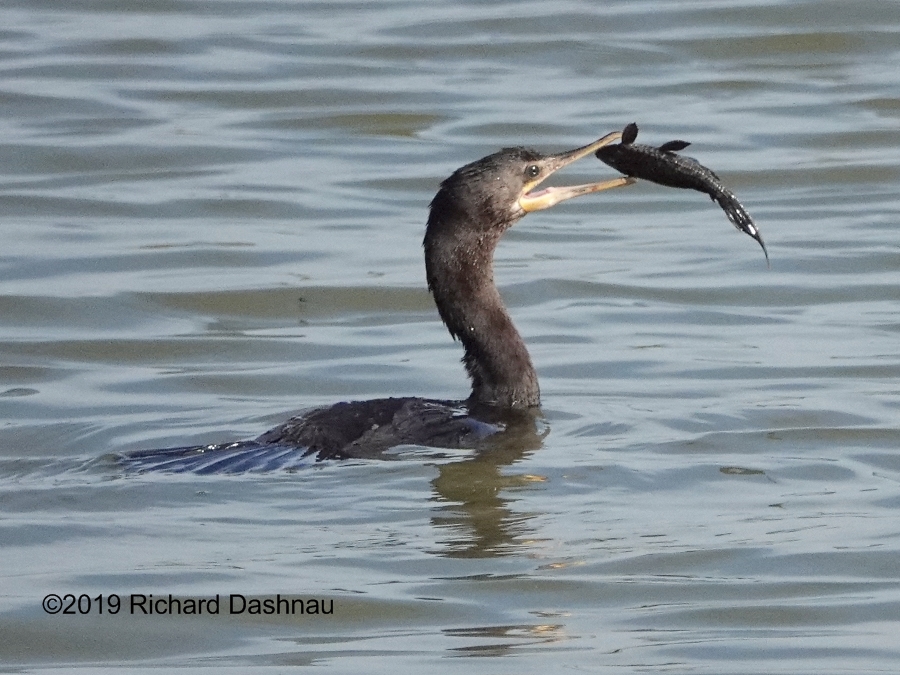
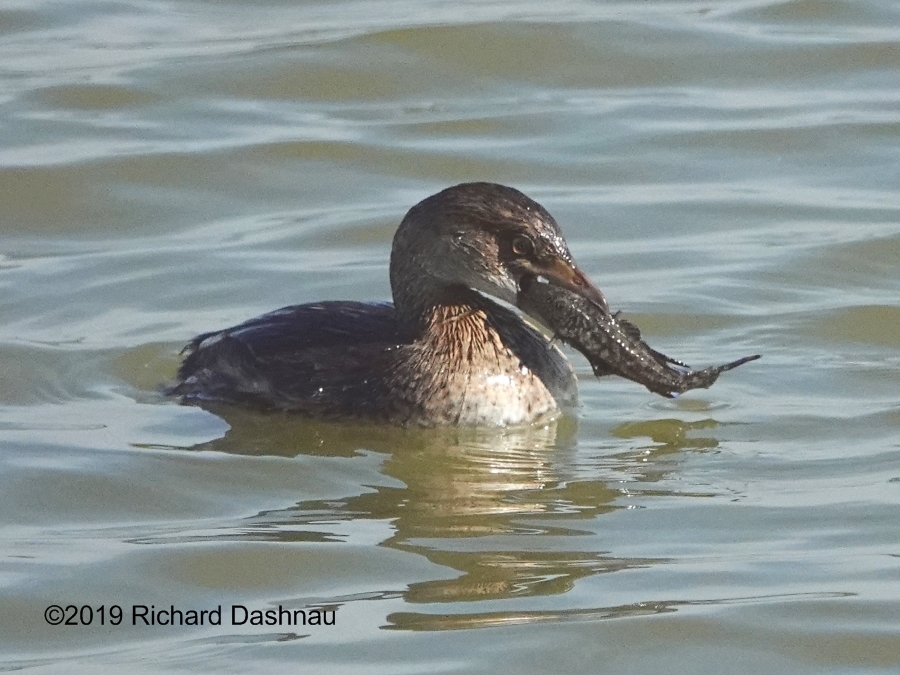
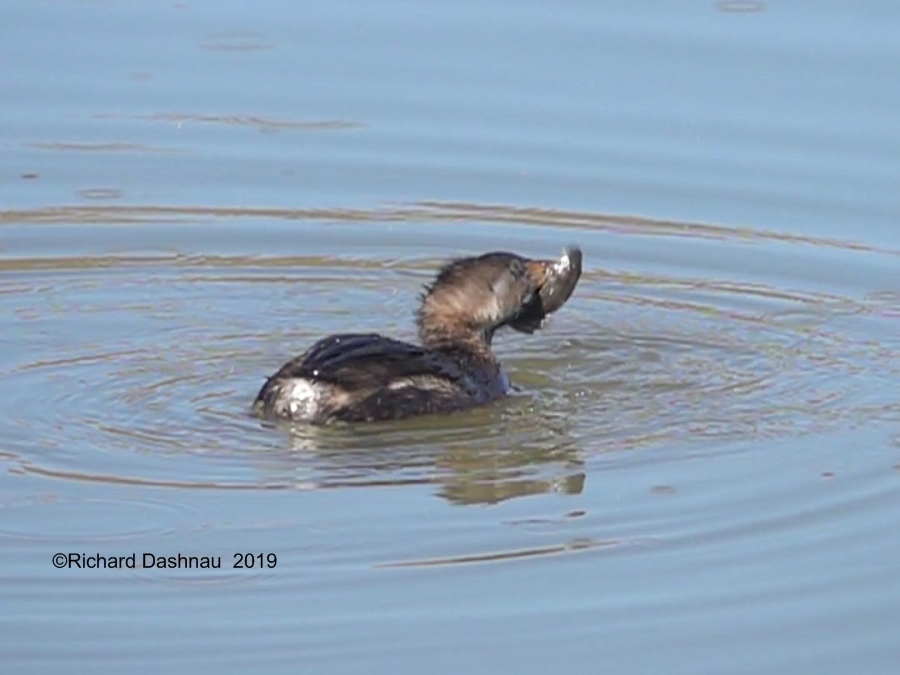



04/01/2017, 04/08/2017
I tried to
see an Eagle at Fiorenza Park again. No luck. But as usual,
Double-Crested Cormorants were active, And for these two days,
they were fishing
close
enough for me to observe them easily. As I have
mentioned before various species of the fish generally known
as Plecostomus have established an invasive presence in Texas.
Most of
the fish being caught by the Cormorants on these two days were
Plecostomus.

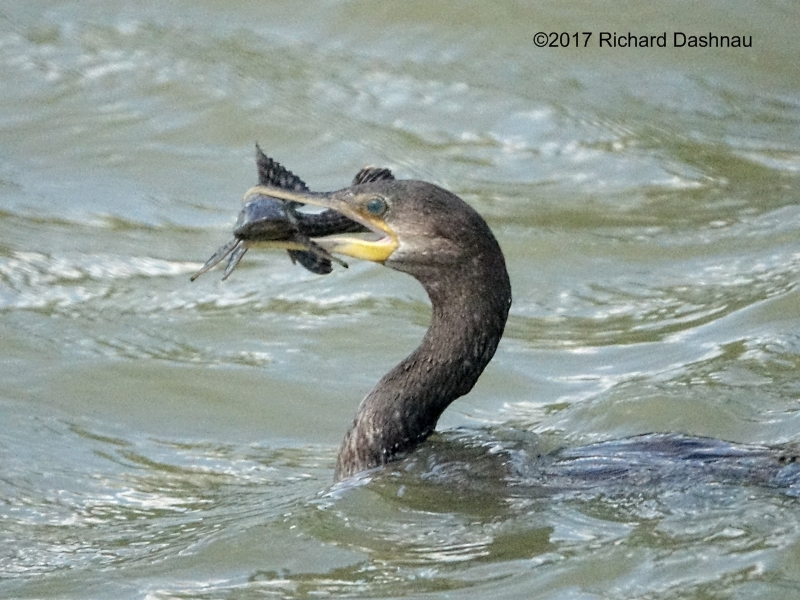
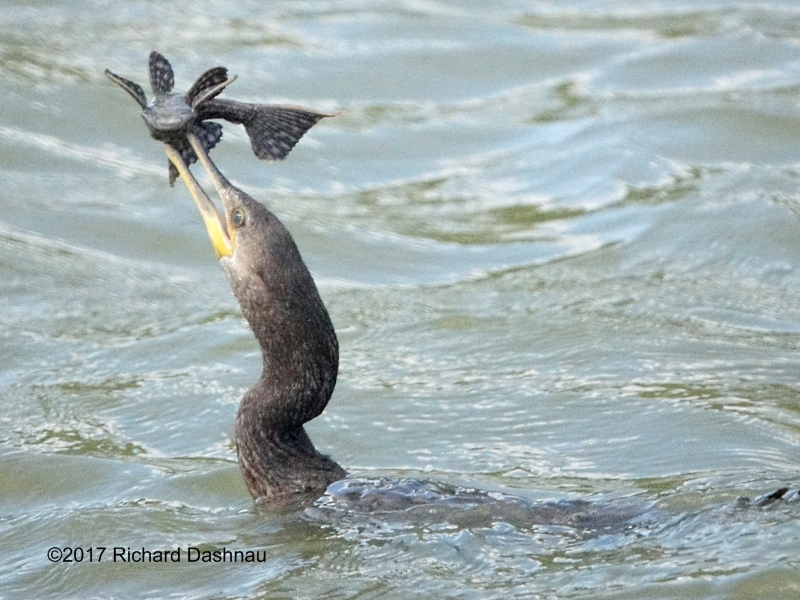
Of the two
similar types of diving birds that I can see in
Texas--Cormorants and Anhingas--I'd always admired the
strategy and habits of the Anhingas. Anhingas swim
totally
submerged, and spear fish with their pointed beak. Then they
surface, shake the impaled fish off their beak, toss it up and
eat it. However, this stabbing attack
may not
work against Plecostomus which are also called "armored
catfish". The Plecostomus don't seem to be much of a problem
for the Cormorants, though.
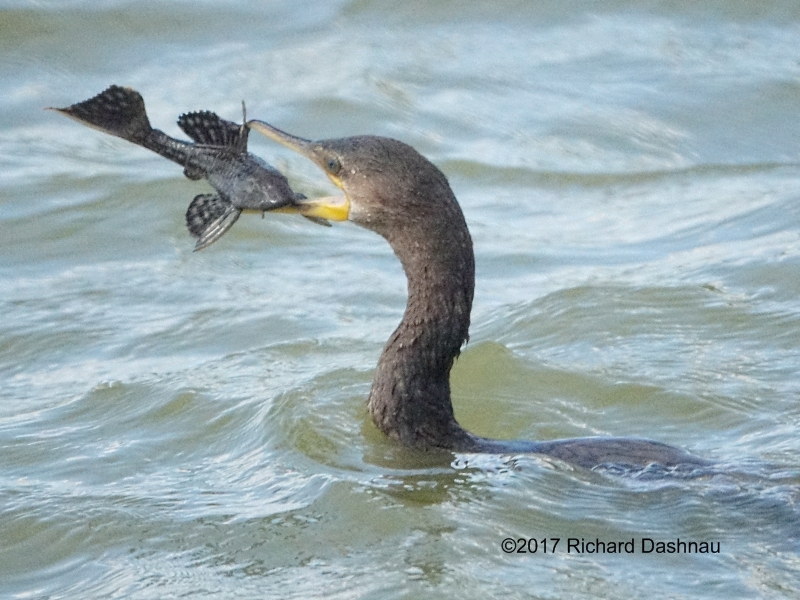
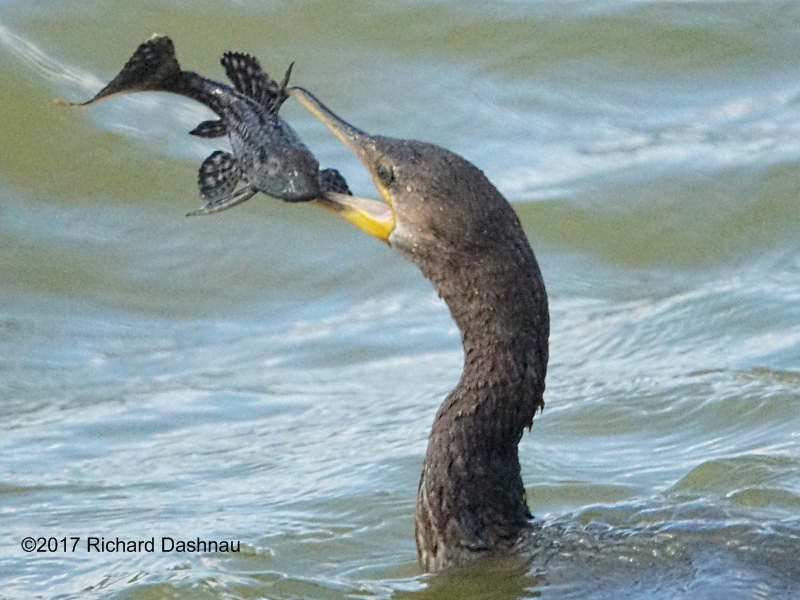
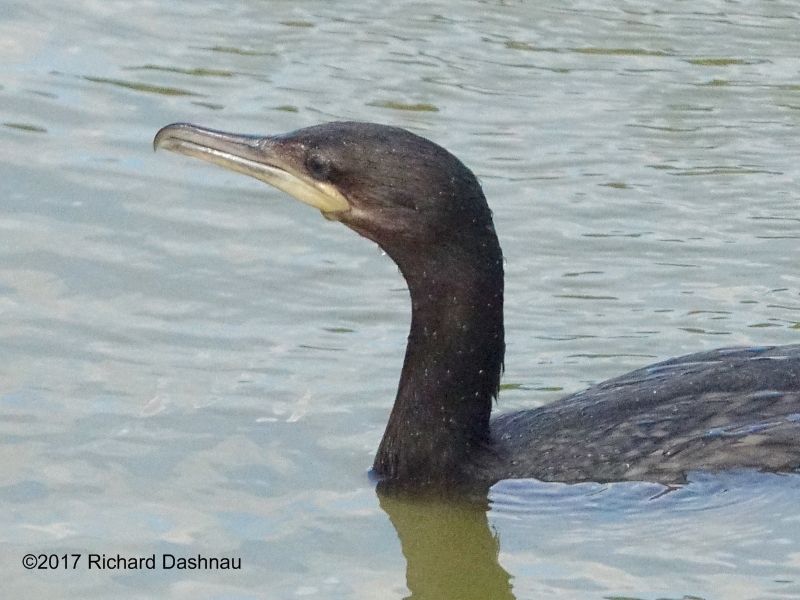
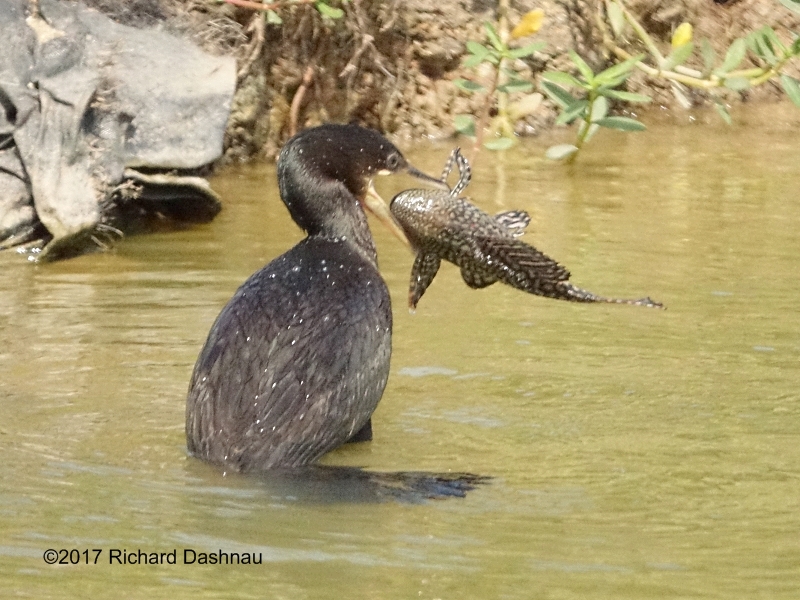
As some of
these pictures show, sometimes a Cormorant was a little too successful,
having caught a fish too large to eat. I saw a few Cormorants
actually give up on fish they'd caught
and just
leave them under water. Some of these close-up shots
really show the hook on the end of their upper mandible--and
how sharp that hook is. The lower mandible fits closely
inside
that hook, and the two parts make the beak a formidable tool
for catching and handling fish.
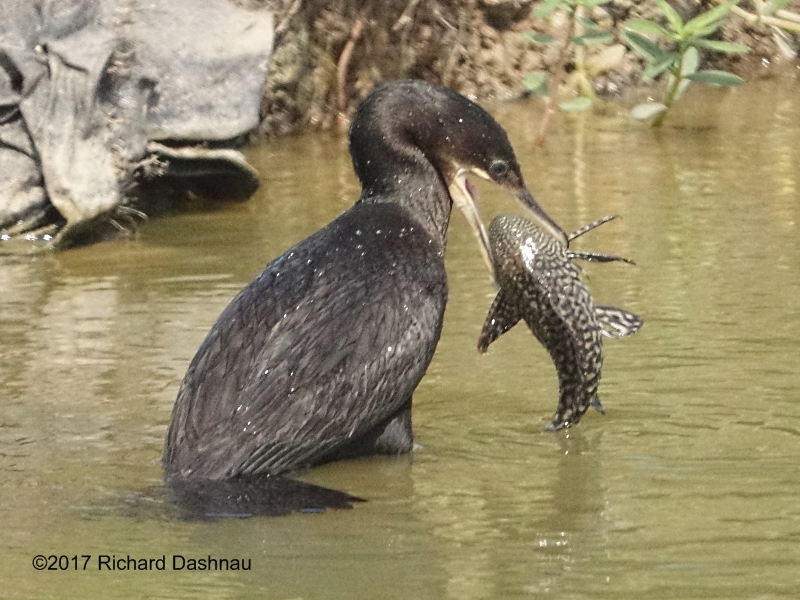

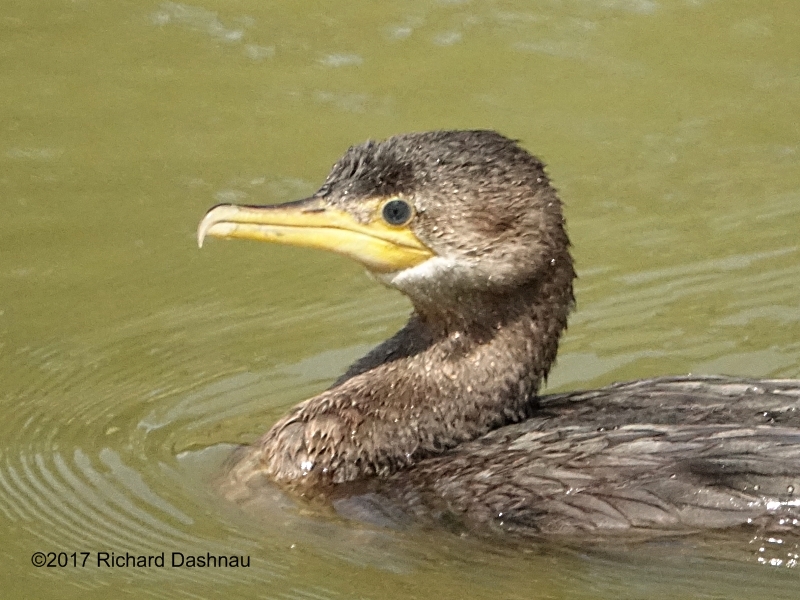
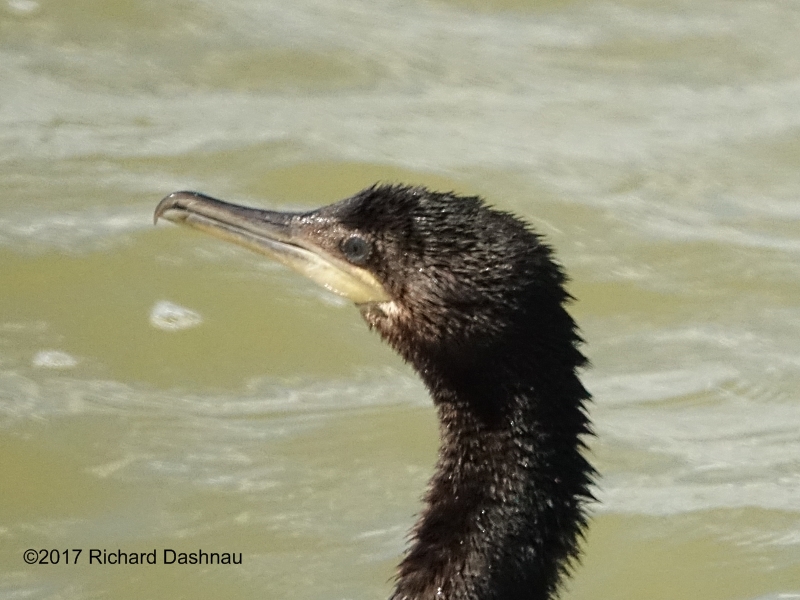
In a few of
the pictures (and in the video clips that I filmed) the
Cormorants used their beak with great dexterity, and were able
to find chinks in the armor covering most of the
body of
the fish--by piercing their eyes, or softer underside.
Sometimes it took a few minutes before the Plecostomus was
weakened enough to be swallowed, but the birds were
usually
successful. The video clips from these two days can be seen here
and here.
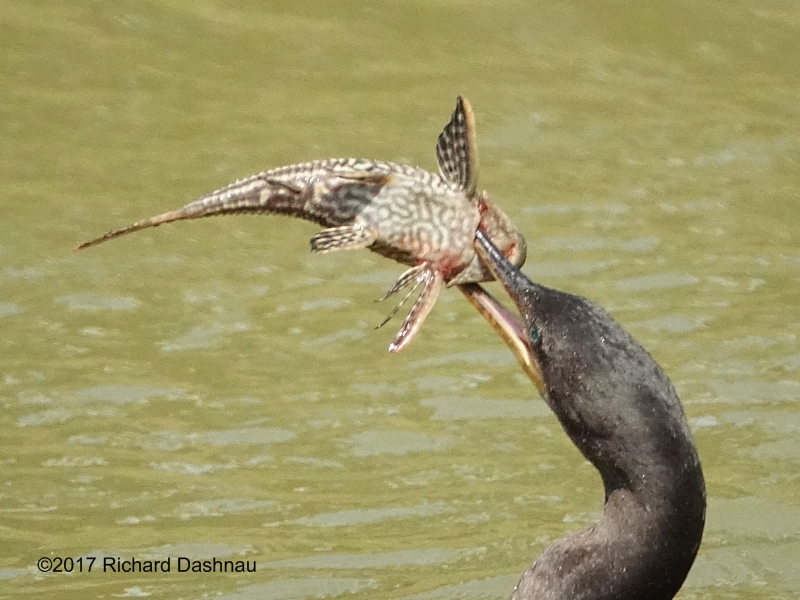
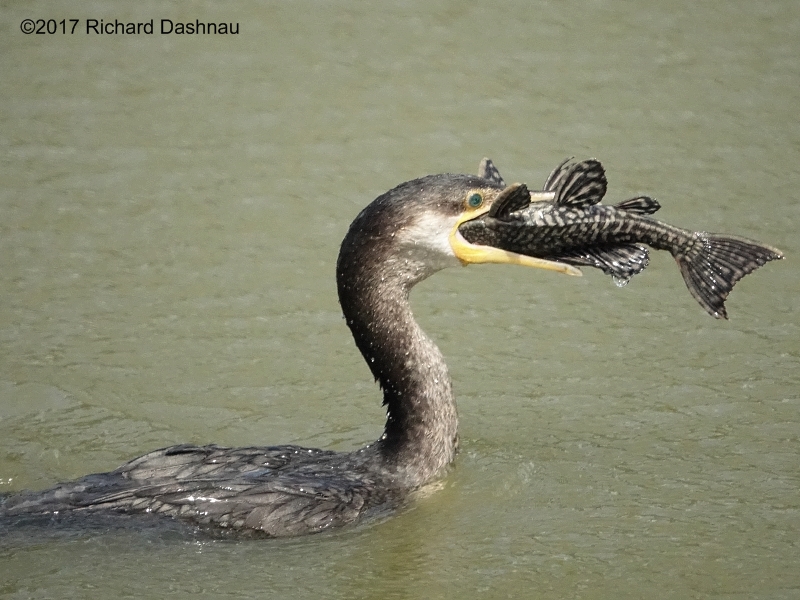
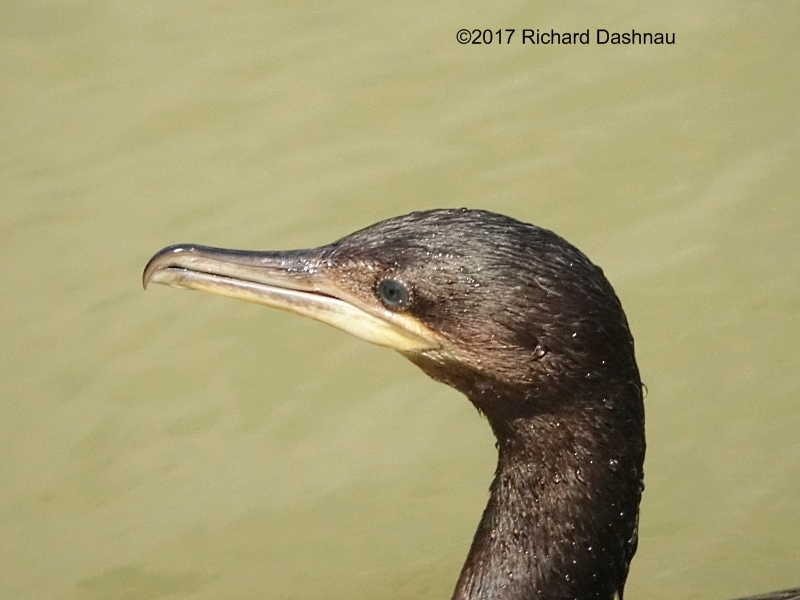
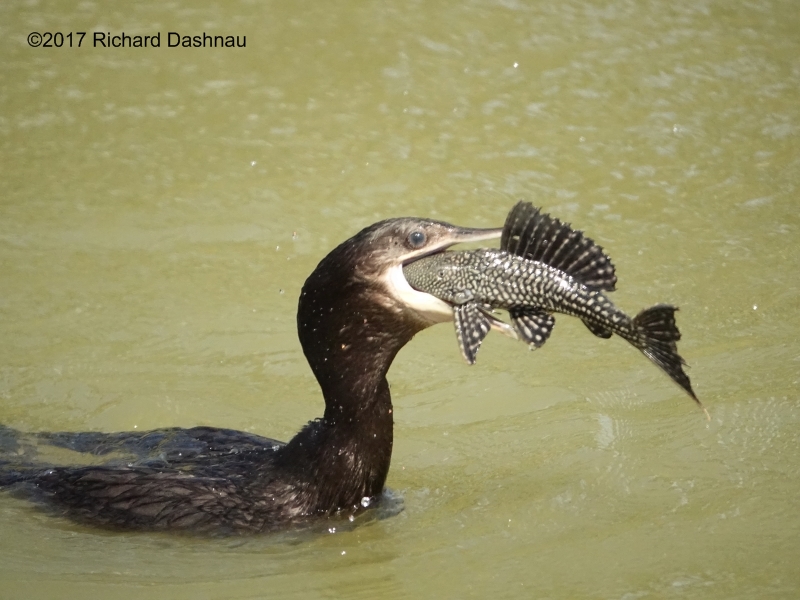
In about 90 minutes, I saw a number of Plecos dispatched (10
or more? I wasn't counting)...just in the area I was watching.
Just imagine the hundreds of invasive Plecostomus
that are probably being removed from Brays Bayou by the Cormorants
in this park in a week!
11/24/2016
-12/26/2016 15 miles from
the center of downtown Houston is Archbishop Fiorenza Park. I
hadn't been there since one visit some years ago, before the
lakes were completed. My friend Chris had been taking
pictures of cormorants out at the
park, so I decided to go back and look for some cormorants
myself. Chris had gotten some pictures of cormorants with
plecostomus that they'd caught, so I hoped for the same luck
he'd had.
(You can see much better pictures taken by Chris and Elisa on
their website--Two Shutterbirds.)
It's a
very, very nice park, featuring some large lakes (which are
expansions of Brays Bayou). And...there are LOTS of
cormorants. I visited the park about 8 times from November 12
- December 24.
The
weather wasn't the best for taking pictures, and the comorants
can be shy. But there is a place between two high spots where
the birds are constantly flying back and forth. Anyone
who wishes to practice catching images
of birds in flight will
certainly
find many opportunities to do so at Fiorenza park. Just stand
near the central bridge that spans the West side of the East
loop to the East side of the West loop and point your camera
at the flying
traffic. The pictures below show
a few of the cormorants going by.
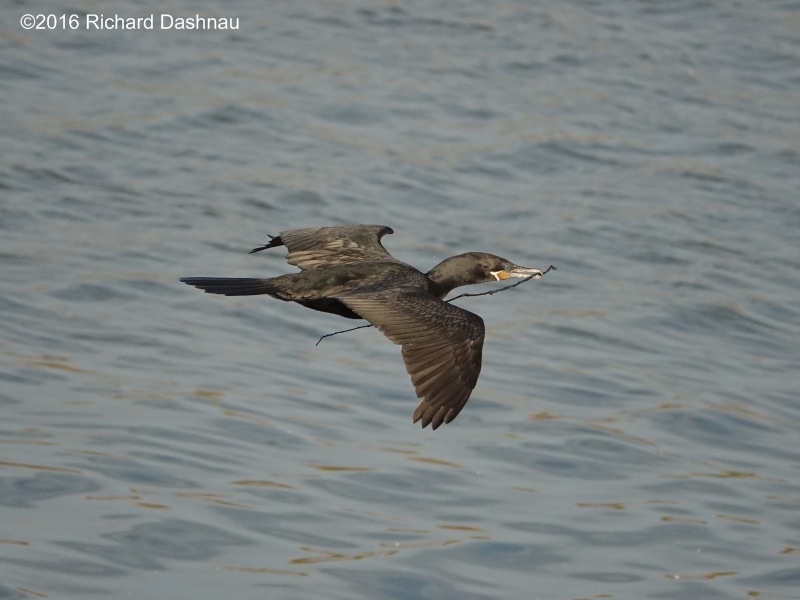
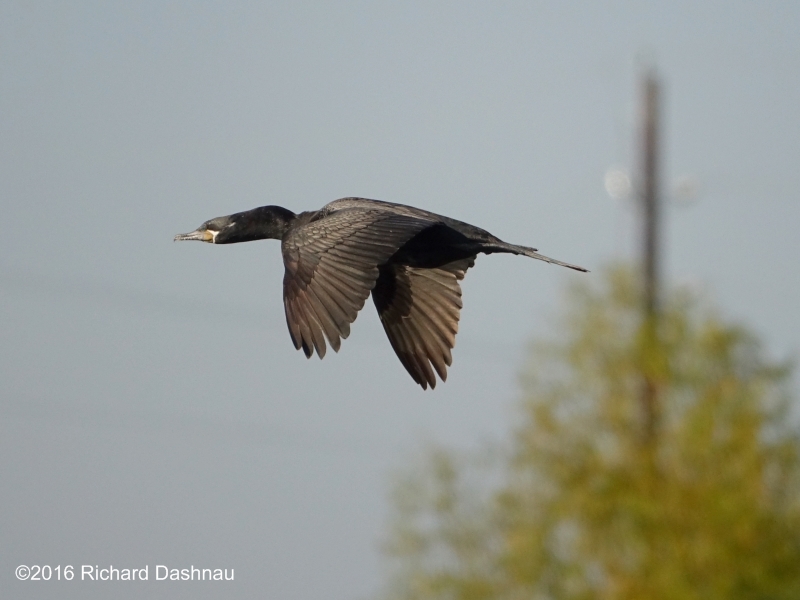
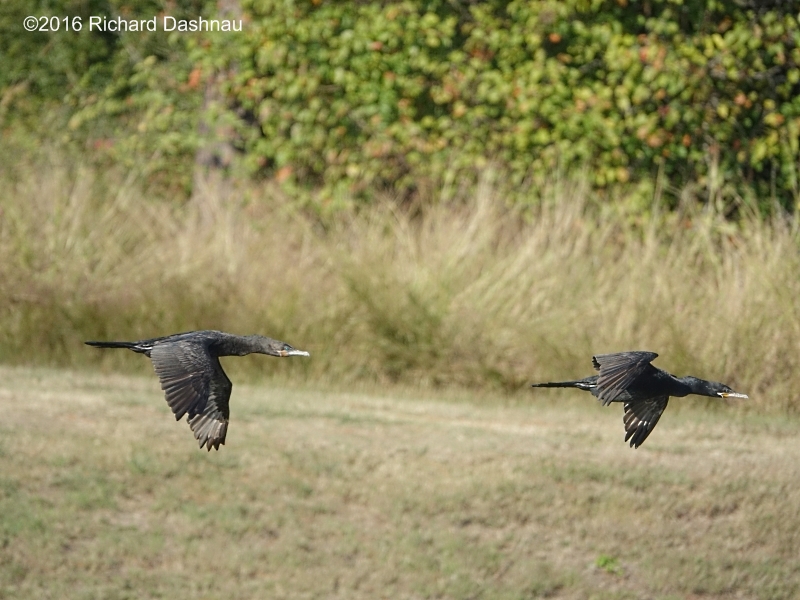
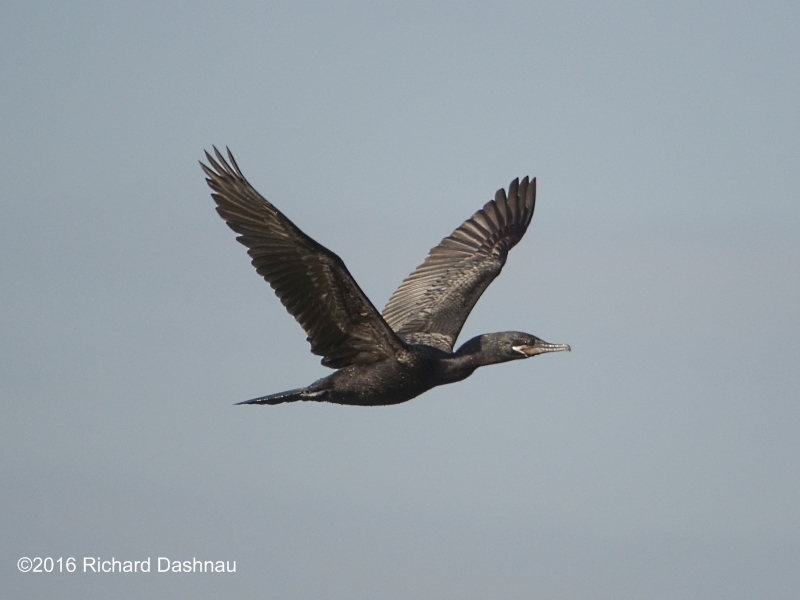
November 26,
2016 Neotropic cormorant November 26,
2016 Neotropic cormorant
November
26,
2016 Neotropic cormorant
November 26,
2016 Neotropic cormorant
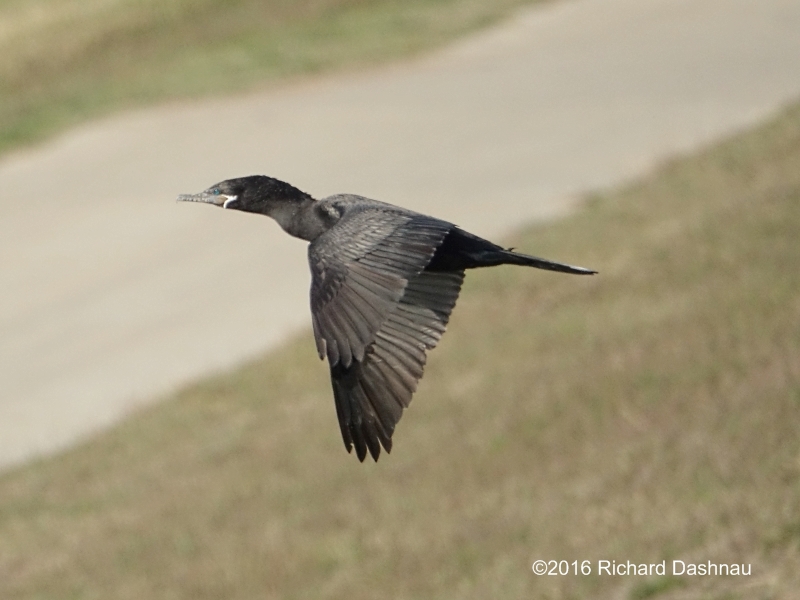
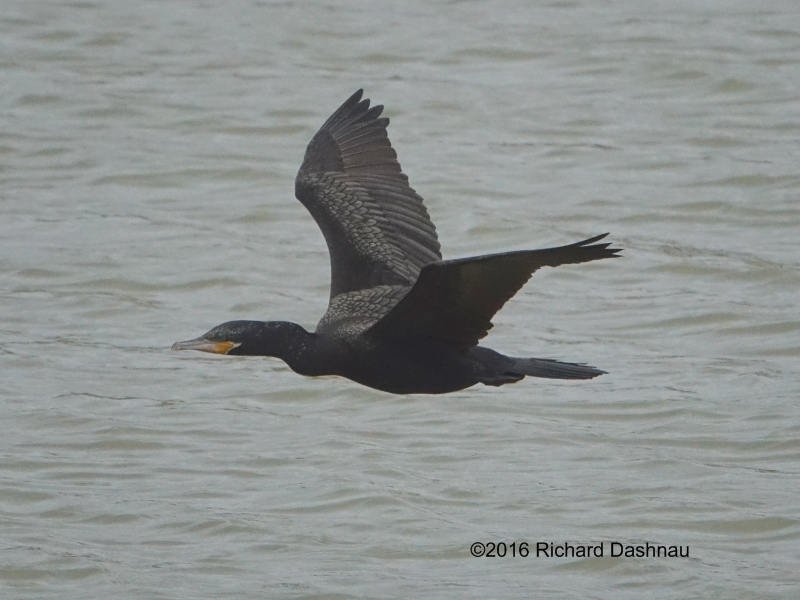
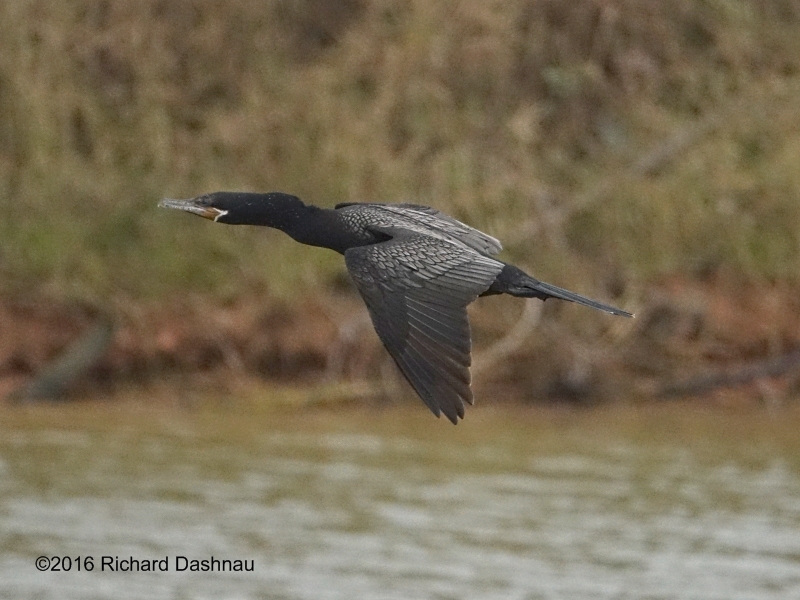
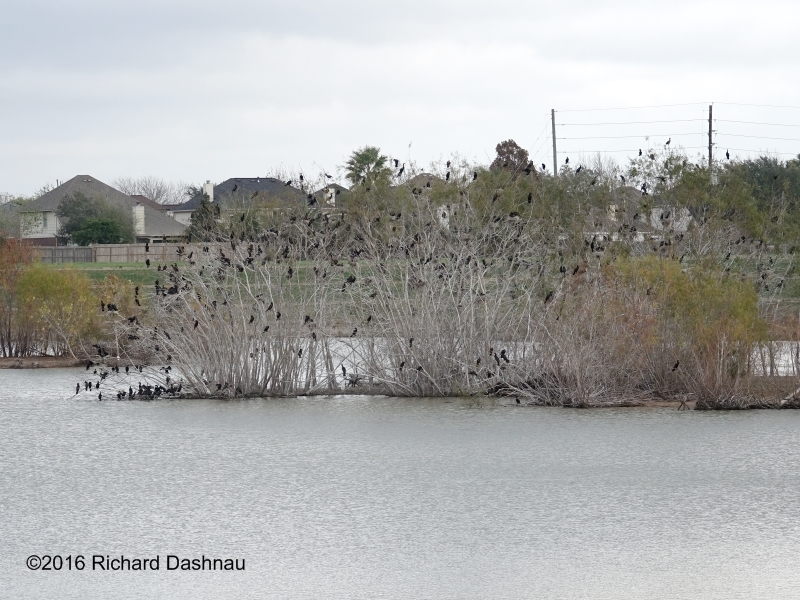
November 26,
2016 Neotropic cormorant December 17,
2016 Neotropic cormorant
December
17,
2016 Neotropic cormorant
December
24,
2016 Trees full of cormorants!
Those that
are swimming tend to stay yards away from where the people
are, but they will occasionally come nearer. I've
watched a single cormorant harvest 5 - 10 plecostomus within
20 minutes. However, the birds
were usually too far away to get good pictures. I
decided to try to take high-frame rate video (480 fps) of
cormorants as they take off from the water. The camera I have
now can shoot these films at higher frame rate
and resolution than I have in the past. Although most of the cormorants
were still pretty far away (at least 25 yards, usually), I can
crop the higher-resolution video for use on my website. And so
I've compiled this film
from clips I collected during that time.
When
birds take off, they have to generate enough air movement over
their wings to generate lift. They can run along the ground,
or hop off the ground, turn into the wind, or fall from a
branch. Things are a bit more
complicated if the bird is floating in deep water. Cormorants
start their takeoff by lifting their wings to prepare for a
downstroke. Then they push back with both broadly
webbed feet then push down with their wings
to lift their body out of the water. While on the same wing
downstroke, they pull their feet forward. The wings go back up
as the feet are striking the water. The feet push back, then
the wings come down. Each wing
downbeat/foot push increases the cormorant's forward speed
until it becomes airborn. Watching the process slowed-down
really emphasizes the effort and coordination required to do
this. The video illustrates
the
take off. And, there are many other birds at Fiorenza park.
Bald Eagles hunt there, and I've seen Ospreys, Roseate
Spoonbills, and magnificent
White
Pelicans!! More pictures and video clips to come.
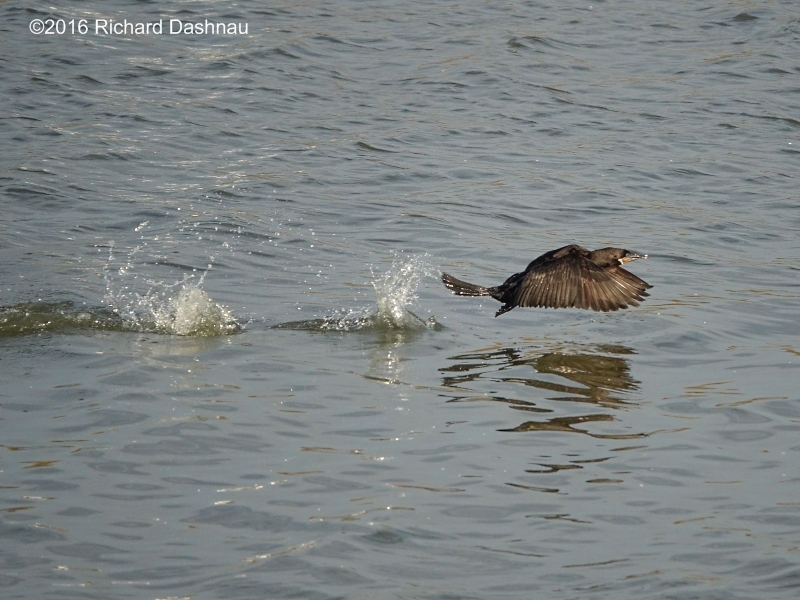
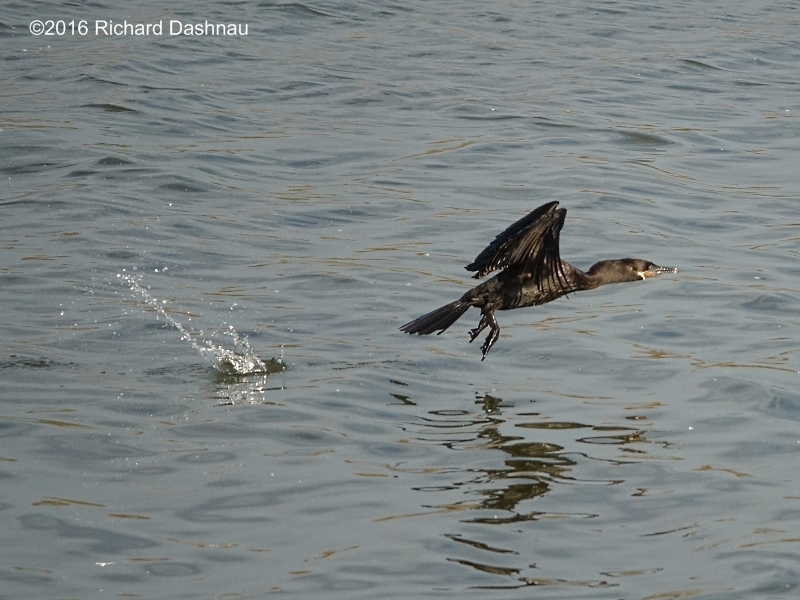
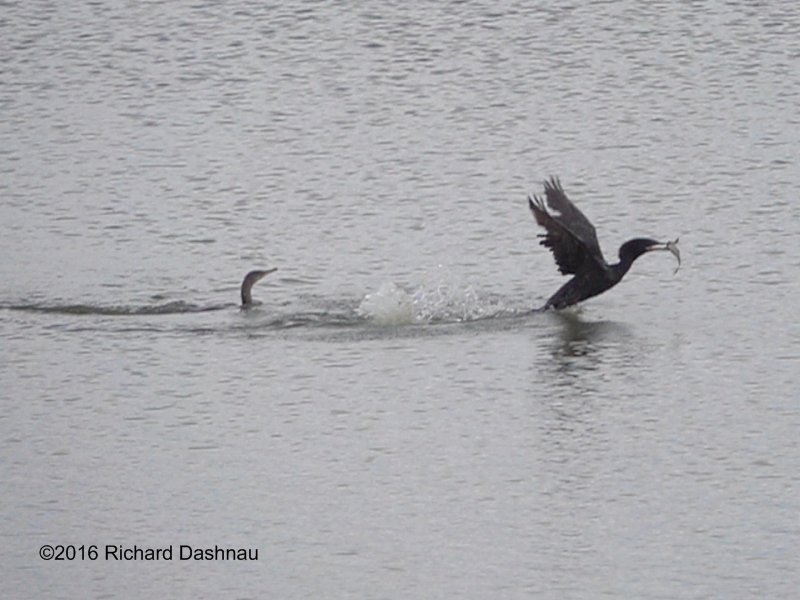
November 26,
2016 Neotropic cormorant November 26,
2016 Neotropic cormorant
Frame
grab from the video
clip.
03/21/2010-- Today, I saw a cormorant with a very large fish.
The fish seems to be a tilapia, but at distance I can't be
sure. The image below is a framegrab from a video clip
that I filmed.
The bird's struggle with this huge meal was amazing.
The video
clip
is here.
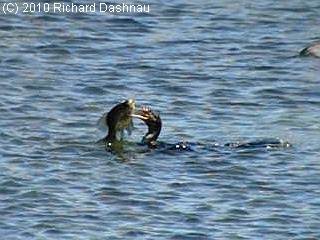
12/21/2008--
Today, I watched a Cormorant as it fished in 40-Acre Lake. The
Cormorant swims with its feathers saturated, but it keeps a pocket
of air close to its body. This helps serve as insulation, but also
causes the
Cormorant to be more bouyant. As I mention on the
other page, both Cormorants and Anhingas will rest after swimming
with their wings spread open. The Cormorant doesn't do this as often
as the Anhinga, and probably
does
it mostly to dry its feathers. Both birds can fly with saturated
wings, though. The image below far right (OLD RICKUBISCAM 122108)
shot is a frame from a video showing a Cormorant as it takes off
from the lake,
and
then lands a bit further away in the lake.
I was able to slow down this event with the camera I
used, and the takeoff seems a bit odd to me. Floating water birds
(Ducks, Coots, Moorhens) seem to "run" on the surface of the water
while flapping their wings. They'll do
this before taking off to fly, or just to cover
distance on the water before floating again. The Cormorant, on the
other hand, seems to hop with both feet! It's quite a sight (in slow
motion) as it pushes against the water with both
feet between wing beats. I'd think it's a
less-efficient method of adding speed than running, but maybe not.
It's possible to see how both feet push back against the water with
each "hop" from the turbulant splashes behind the
bird. The images below are other frames from the
video. SECOND HOP shows as both feet slap the water while the wings
are prepared for the next beat. The splash from the first hop is still
spreading. FEET KICKING BACK
shows the splashes from a number of hops, with the
feet pushing back as the wings push down. FINAL HOP shows the two
dimples in the water under the Cormorant's tail as the feet made
contact, but not enough for a good
push. LAST TOUCHDOWN OF THE FEET shows the feet as they
just barely scrape the water as the Cormorant becomes fully-airborne.
Note that the water from more than one previous splash is still in the
air. This happens
quickly. I can't remember if the bird was flying into
the wind...but it was a bit chilly outside. This camera is great for
slowing these events down! The video clip (shot at 210 fps) can be
seen here
(wmv
4.6 mb).
2/26/2015
I've compiled larger and improved versions of the clip and links to
them are here: wmv
mp4
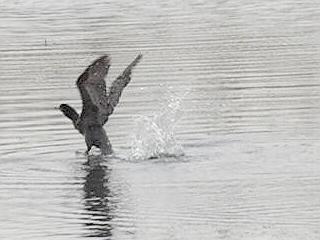 -
-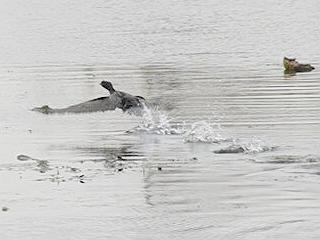 -
-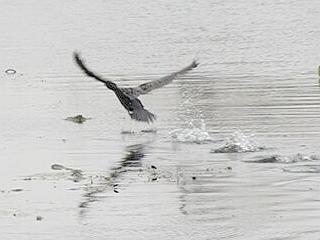 -
-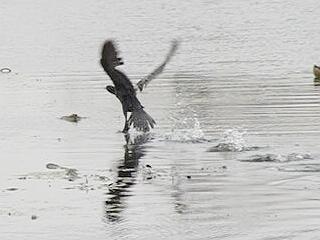 -
-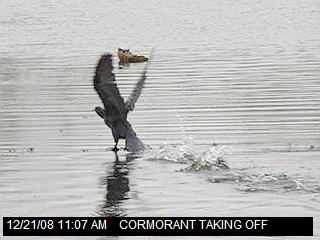
SECOND
HOP
FEET
KICKING
BACK
FINAL
HOP
LAST
TOUCH OF THE FEET
OLD RICKUBISCAM 122108
8/24/2008--
I've been trying to see more Anhinga behavior since my last
"discovery" about their heating being related to the wing-spreading
posture. Today, I saw an Anhinga and a Neotropic Cormorant right
next to each other. Now I can show
a few comparisons between these
two diving birds. Today's RICKUBISCAM shows a single frame from a
video clip showing a Cormorant swimming. The clip will have a link
further down.
I watched the Anhinga and the Cormorant for a while.
During that time, one or the other would occasionally
enter the water to fish. After a time, the Anhinga would pop out of
the water. It would suddenly leap out of the water appear on one of
the tree trunks. The Cormorant would appear from a
distance away, and leap out of the water and fly right
back to the tree shown in the images below. The photos below (Anhinga
and Cormorant, Profile, Anhinga) are all frames from this short video
clip. The clip shows each in closer shot in the
trees, then pulls back to show them at the same time.
The video shows the differences between the two birds, especially the
shape of the beak. From what I've recently learned, the fact that the
Anhinga has spread its wings while the Cormorant
has NOT isn't surprising. During the entire time I saw
both birds (at least an hour), the Cormorant did not make the "wing
spread" posture at all. The Anhinga must use its wings as solar
collectors to heat its body; while the Cormorant may
occasionally spread its wings to hasten drying.
-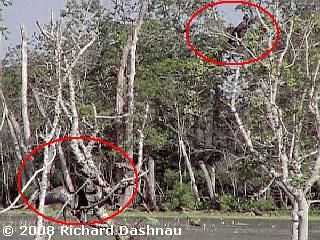 --
--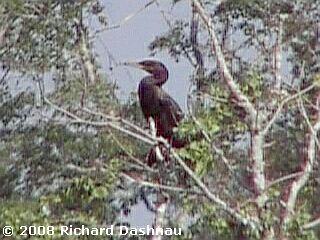 --
--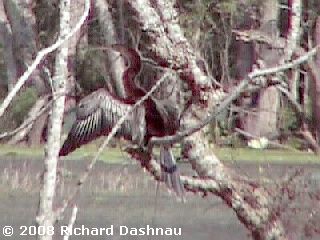
ANHINGA AND CORMORANT
THE CORMORANT PROFILE
THE
ANHINGA
Anhinga
and
Cormorant video (wmv 8.5mb).
- --
--
THE CORMORANT SWIMS
THE CORMORANT
LOOKS DOWN
Cormorant
swims
video (wmv 5.0mb).
I was able to capture a some short video footage of the
Cormorant swimming. The RICKUBISCAM shows one frame from this video.
Two other frames are above (Cormorant swims; Cormorant Looks Down).
The images and video
clearly show how high the Cormorant's back is above the water. The
Cormorant is more buoyant because of a layer of air that it keeps
near its body. This layer also acts as insulation against the
heat-dissipation effects of being
submerged in water.
Finally, an Anhinga took off from the tree and flew away from me,
then circled back and landed in the water. I was able to catch part
of this flight on video.
The image below is a frame from
the video clip. The video clip shows it entering the water. The
Anhinga immediately sinks--but a very small part is briefly visible
for a few seconds. I suspect this is because there was still some
air
trapped in voids among the feathers. Whatever the reason, once the
Anhinga dives, it remains totally submerged except for its head and
neck. In the video, one can see why the Anhinga is sometimes called
a "snakebird".
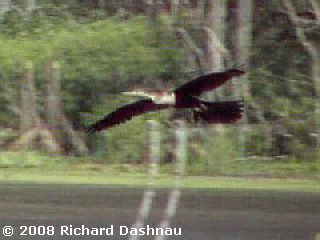
THE ANHINGA LANDING
Anhinga
lands
video (wmv 5.0mb).
Go back to my home page, Welcome to
rickubis.com
Go back to the RICKUBISCAM
page.
Go back to the See
the World page.





































































 -
- -
- -
- -
-
 --
-- --
--
 --
--
